Refer to Exhibit.

PC2 is directly connected to R1. A user at PC2 cannot Telnet to 2001:db8:a:b::10. The user can ping
2001:db8:a:b::10 and receive DHCP-related information from the DHCP server. Which action resolves
the issue?
Refer to the exhibit.
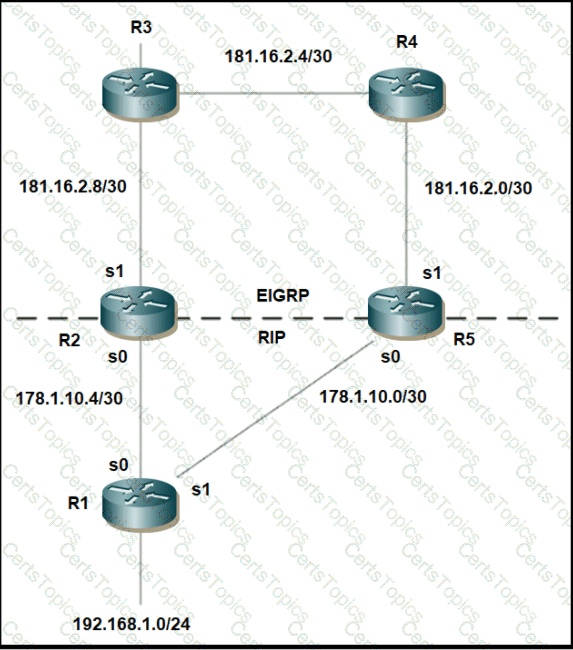
Mutual redistribution is enabled between RIP and EIGRP on R2 and R5. Which configuration resolves the routing loop for the 192.168.1.0/24 network?
Refer to the exhibit.
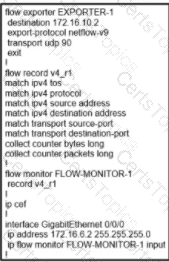
An engineer configured NetFlow to capture traffic information through the router, but it iOS not working as expected. Which action captures the flow information from this router to the collector?
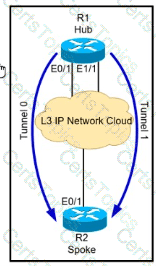
Refer to me exhibit. The hub and spoke are connected via two DMVPN tunnel interfaces The NHRP is configured and the tunnels are detected on the hub and the spoke Which configuration command adds an IPsec profile on both tunnel interfaces to encrypt traffic?
What is an MPLS LDP targeted session?
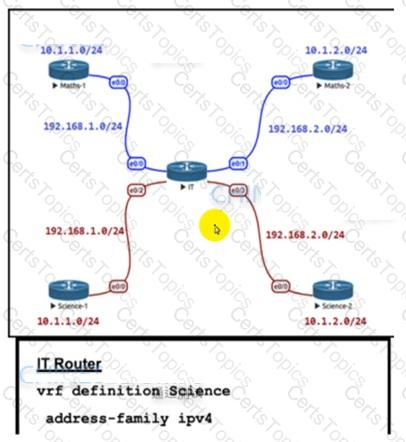
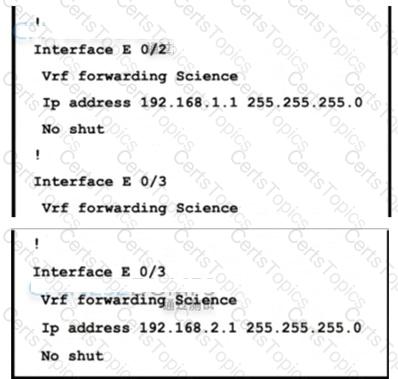
Refer to the exhibit. The IT router has been configured with the Science VRF and the interfaces have been assigned to the VRF. Which set of configurations advertises Science-1 and Science-2 routes using EIGRPAS 111?

Refer to the exhibit.

Although summarization is configured for R1 to receive 10.0.0.0/8. more specific routes are received by R1. How should the 10.0.0.0/8 summary route be received from the neighbor, attached to R1 via Fast Ethernet0/0 interface?
Refer to the exhibit.
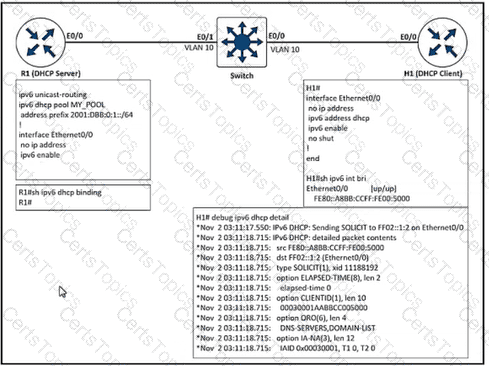
After the network administrator rebuilds the IPv6 DHCP server, clients are not getting the IPv6 address lease. Which action resolves the issue?
Which IPv6 first hop security feature controls the traffic necessary for proper discovery of neighbor device operation and performance?
A newly installed spoke router is configured for DMVPN with the ip mtu 1400 command. Which configuration allows the spoke to use fragmentation with the maximum negotiated TCP MTU over GRE?
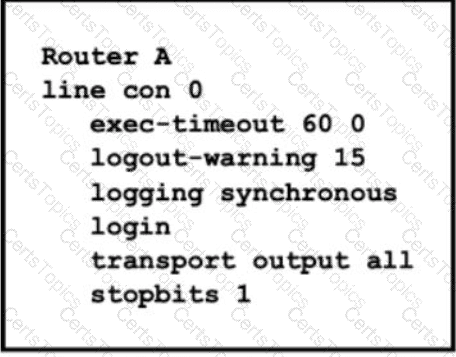
Refer to the exhibit After a misconfiguration by a junior engineer, the console access to router A is not working Which configuration allows access to router A?
A)

B)

C)

D)
Refer to the exhibit.

An engineer must advertise routes into IPv6 MP-BGP and failed. Which configuration resolves the issue on R1?
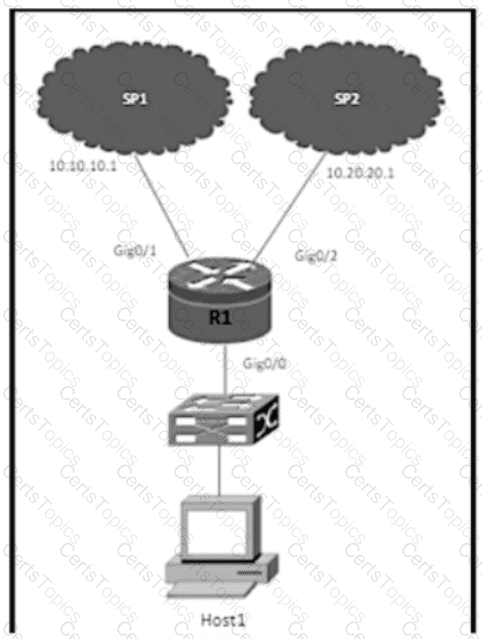
Refer to the exhibit. R1 uses SP1 as the primary path. A network engineer must force all SSH traffic generated from R1 toward SP2. Which configuration accomplishes the task?
A)
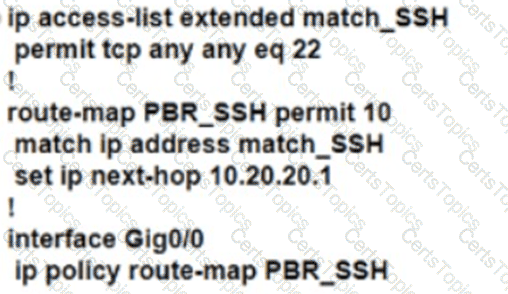
B)
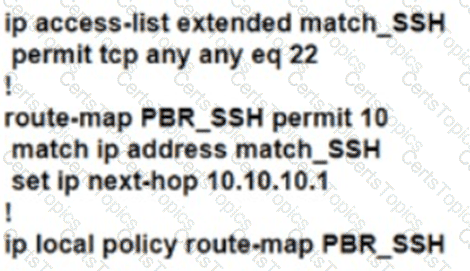
C)
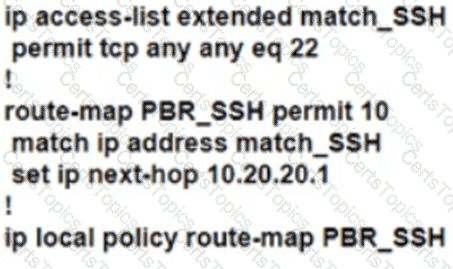
D)
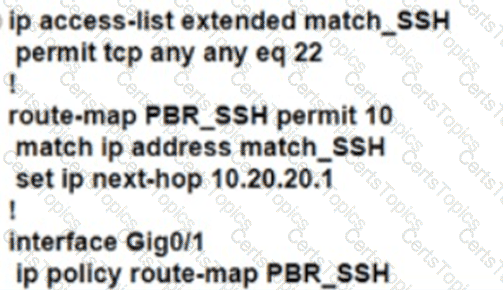
Refer to the exhibit.
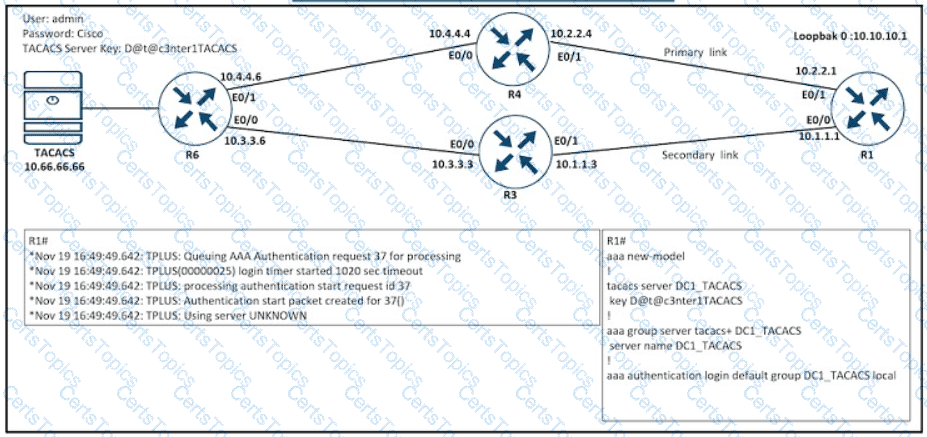
Refer to the exhibit R1 cannot authenticate via TACACS Which configuration resolves the issue?

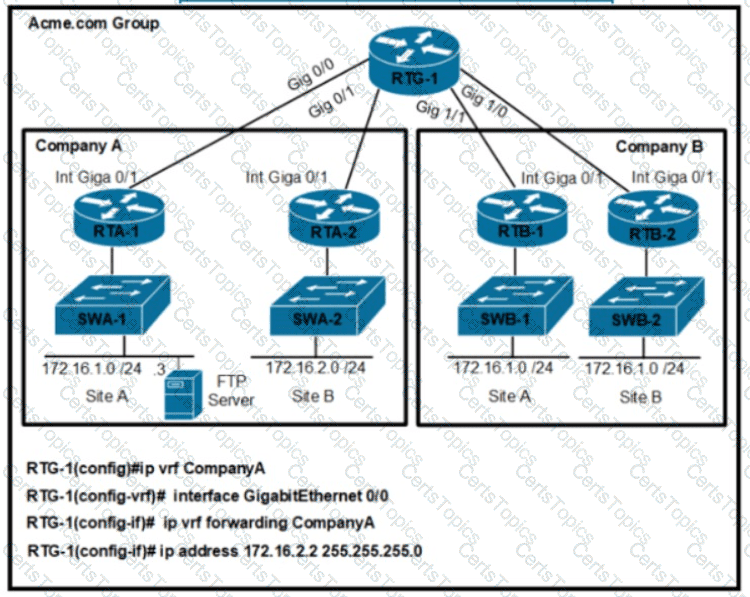
Refer to the exhibit. An engineer must configure a per VRF for TACACS+ for company A. Which configuration on RTG-1 accomplishes the task?
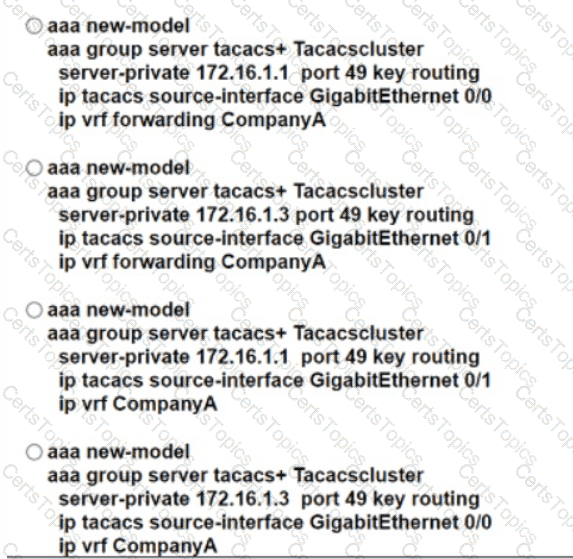
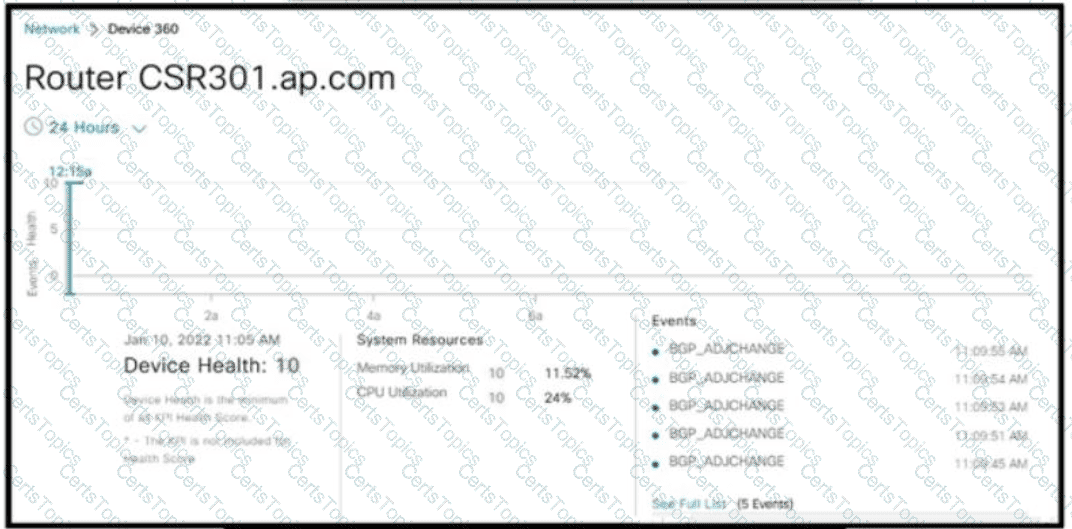
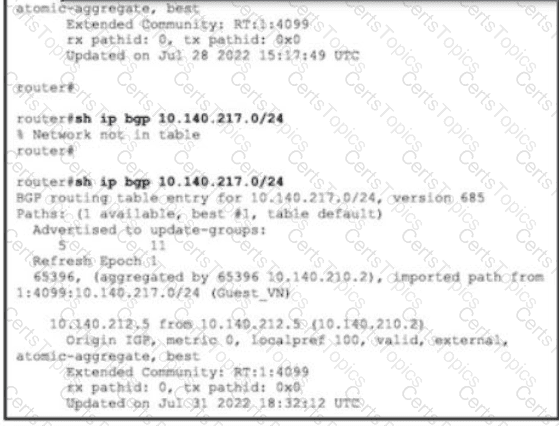
Refer to the exhibit. In Cuco DNA Center, a network engineer identifies that BGP-learned networks are repeatedly withdrawn from peers. Which configuration must the engineer apply to resolve the Issue?
A)

B)

C)

D)

:579
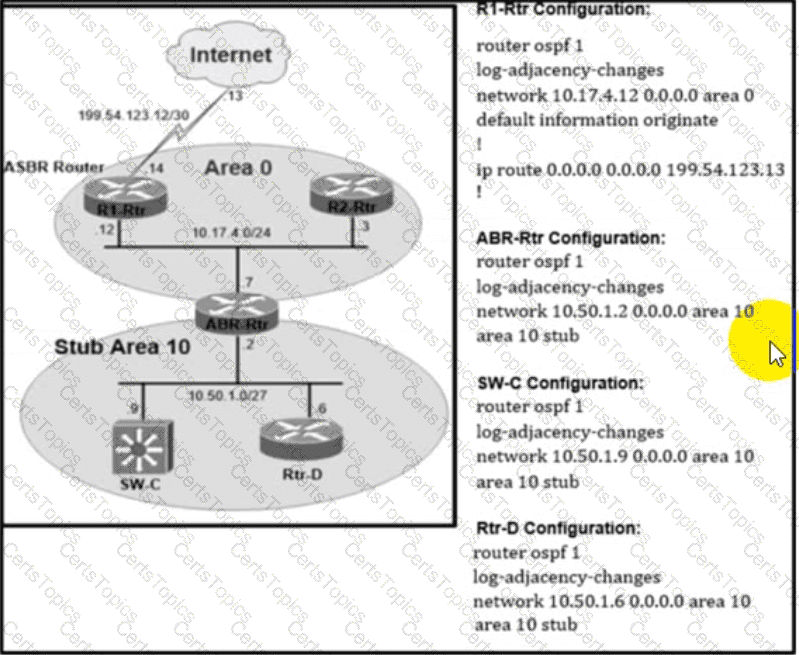
Refer to the exhibit. Router ABR-Rtr is not propagating the internet routes in OSPF area 10. which causes internet reachability problems in the area. Which action resolves the issue?
Refer to the exhibit.
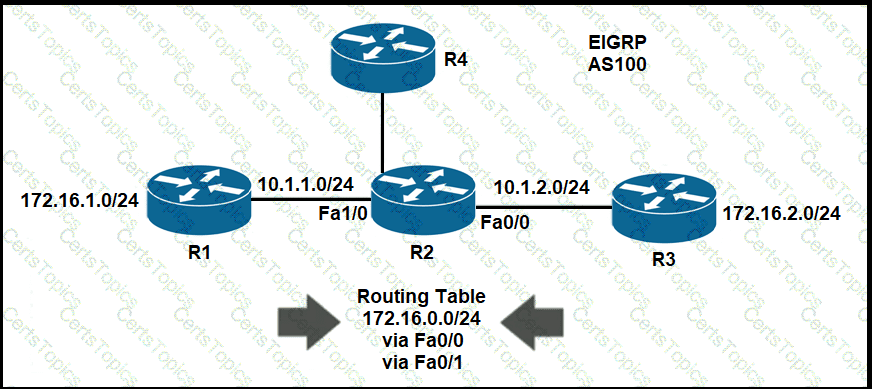
R4 is experiencing packet drop when trying to reach 172.16.2.7 behind R2. Which action resolves the issue?
Which feature minimizes DoS attacks on an IPv6 network?
Refer to the exhibit.
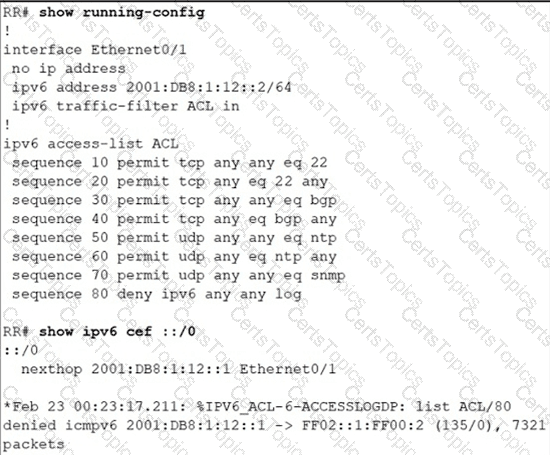
After a security audit, the administrator implemented an ACL in the route reflector. The RR became unreachable from any router in the network. Which two actions resolve the issue? (Choose two.)

Refer to the exhibit. A network engineer configured routers R1 and R2 with MP-BGP. The engineer noticed that the routers cannot exchange any IPv6 routes, however, the IPv4 neighbor relationship is working fine. Which configuration must the engineer apply to router R2 to exchange IPv6 routes?
:586
While BGP internet routes are redistributed to a lower class of router via RIP. packets are being dropped and routes are failing to be distributed in RIP. Which action resolves the issue?
Refer to the exhibit.
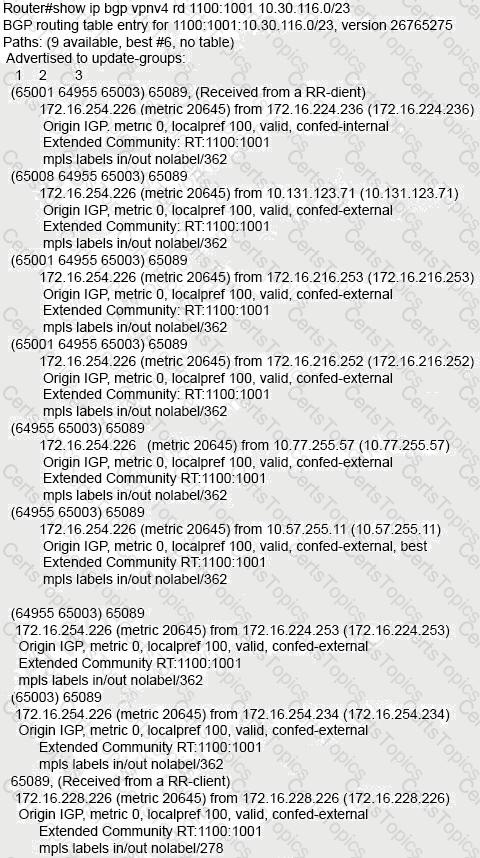
An engineer configured BGP and wants to select the path from 10.77.255.57 as the best path instead
of current best path. Which action resolves the issue?

Refer to the exhibit R2 can reach Loopback222, but R1 SW1 and PC1 cannot communicate with 172.16.222 254 R1 and R2 configurations are shown here
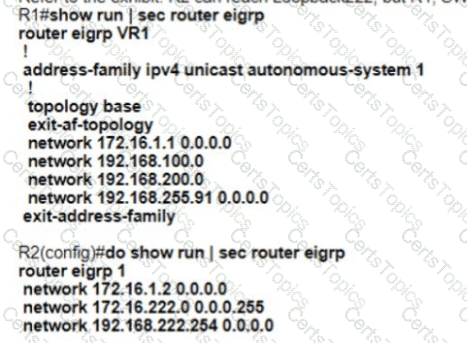
Which EIGRP configuration command resolves the issue?
Refer to the exhibit.
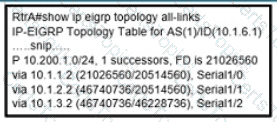
Which action makes 10.1.3.2 the feasible successor to reach 10. 200. 1 0/24 for location S42T447E33F95?
:588
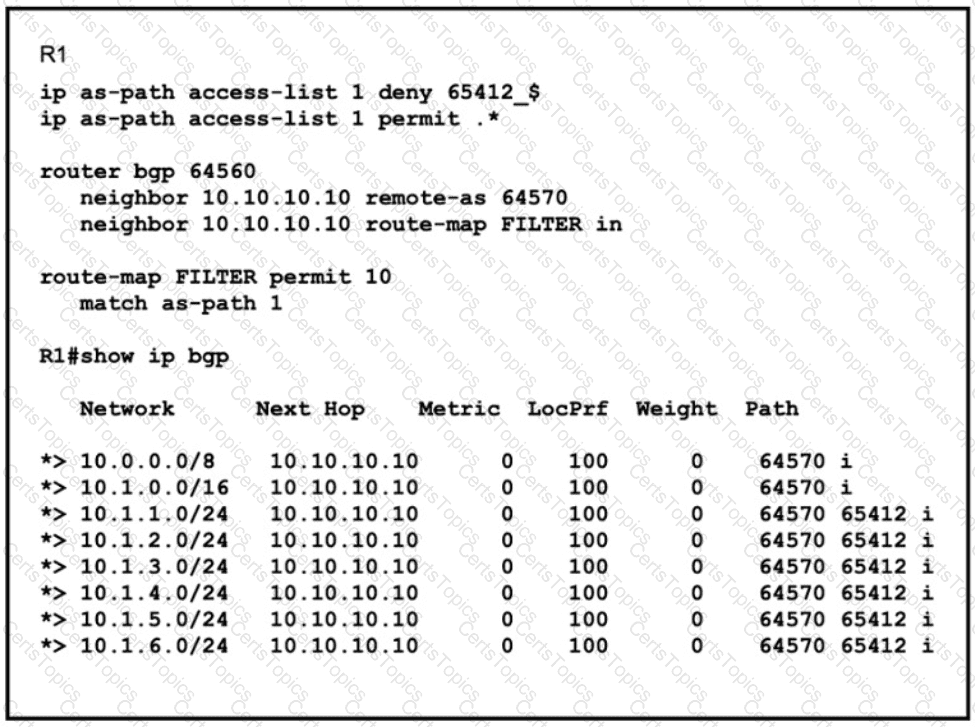
Refer to the exhibit. An engineer must filter prefixes that originate from AS65412. but it is not working correctty. Which configuration must the engineer apply to R1 to resolve the issue?
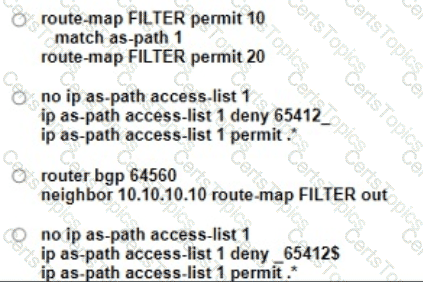
What is LDP label binding?
Refer to the exhibit.
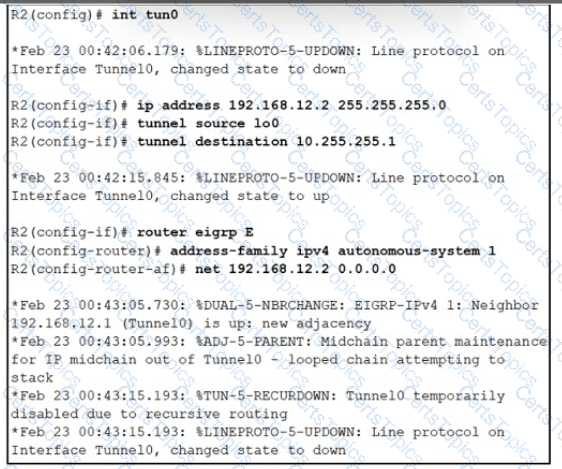
An administrator is configuring a GRE tunnel to establish an EIGRP neighbor to a remote router. The other tunnel endpoint is already configured. After applying the configuration as shown, the tunnel started flapping. Which action resolves the issue?
Refer to the exhibit.
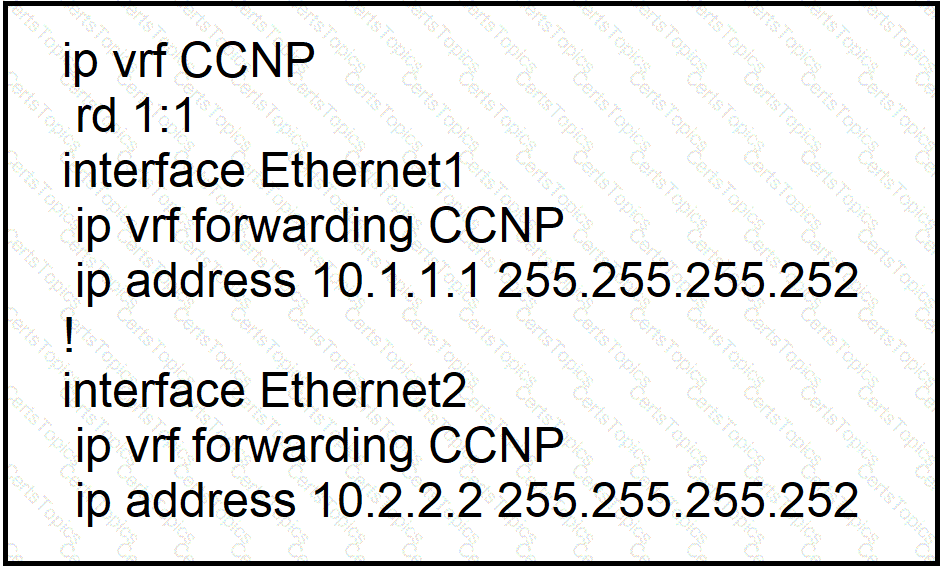
Which configuration enables OSPF for area 0 interfaces to adjacency with a neighboring router with the same VRF?
What is a function of an end device configured with DHCPv6 guard?
How is VPN routing information distributed in an MPLS network?
Refer to the exhibit.
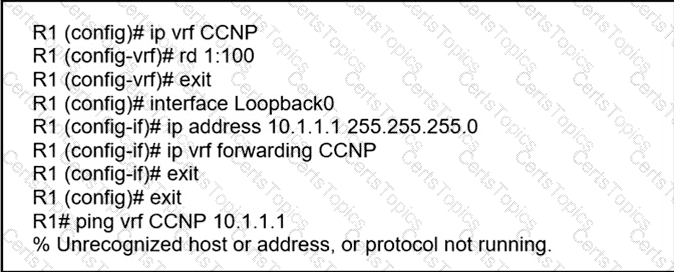
Which command must be configured to make VRF CCNP work?
Refer to the exhibit.
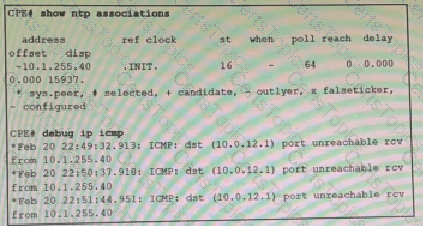
An administrator is troubleshooting a time synchronization problem for the router time to another Cisco IOS XE-based device that has recently undergone hardening. Which action resolves the issue?
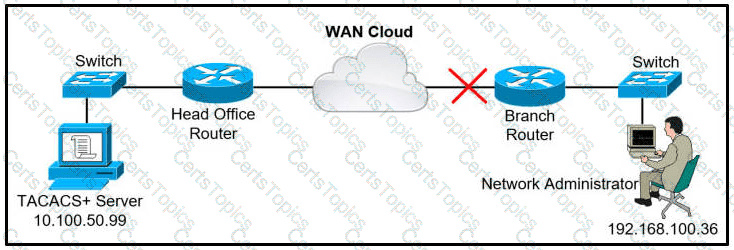
A network administrator is trying to access a branch router using TACACS+ username and password credentials, but the administrator cannot log in to the router because the WAN connectivity is down. The branch router has following AAA configuration:

Which command will resolve this problem when WAN connectivity is down?
Refer to the exhibit.
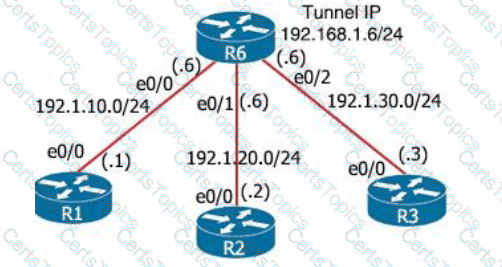
An engineer must establish multipoint GRE tunnels between hub router R6 and branch routers R1, R2, and R3. Which configuration accomplishes this task on R1?
A)
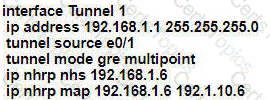
B)
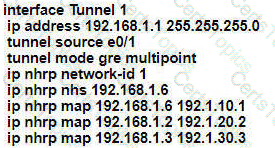
C)

D)
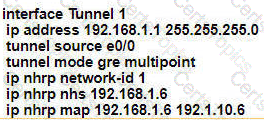
Refer to the exhibit.
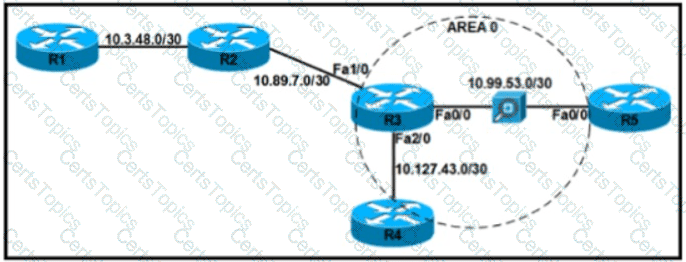
The security department recently installed a monitoring device between routers R3 and R5, which a loss of network connectivity for users connected to R5. Troubleshooting revealed that the monitoring device cannot forward multicast packets. The team already updated R5 with the correct configuration. Which configuration must be implemented on R3 to resolve the problem by ensuring R3 as the DR for the R3-R5 segment?
A)
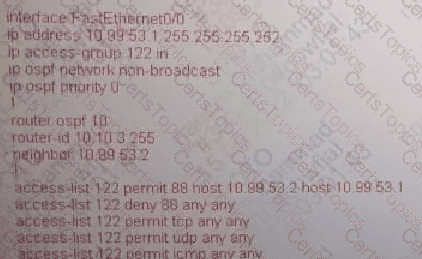
B)
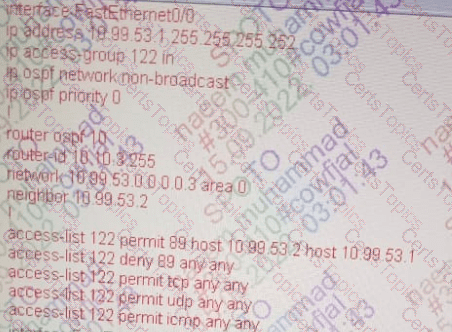
C)

D)
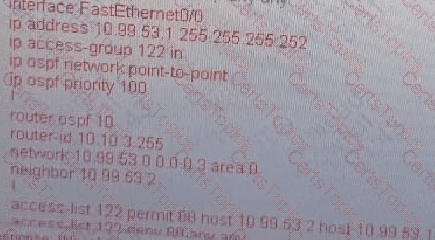
Refer to the exhibit.

When the FastEthemet0/1 goes down, the route to 172.29.0 0/16 via 192.168.253 2 is not installed in the RIB. Which action resolves the issue?

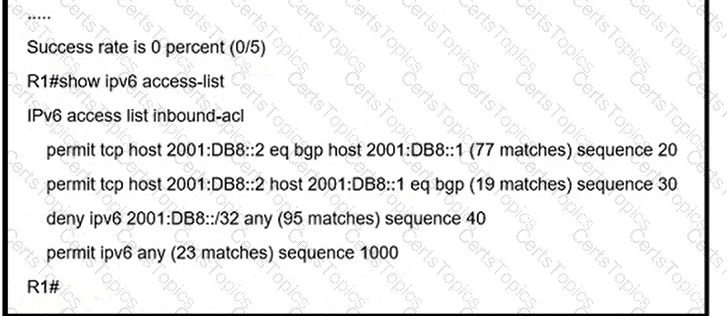
Refer to the exhibit. An engineer applied filter on R1 The interface flapped between R1 and R2 and cleaning the BGP session did not restore the BGP session and failed Which action must the engineer take to restore the BGP session from R2 to R1?
Which technique removes the outermost label of an MPLS-tagged packet before the packet is forwarded to an adjacent LER?
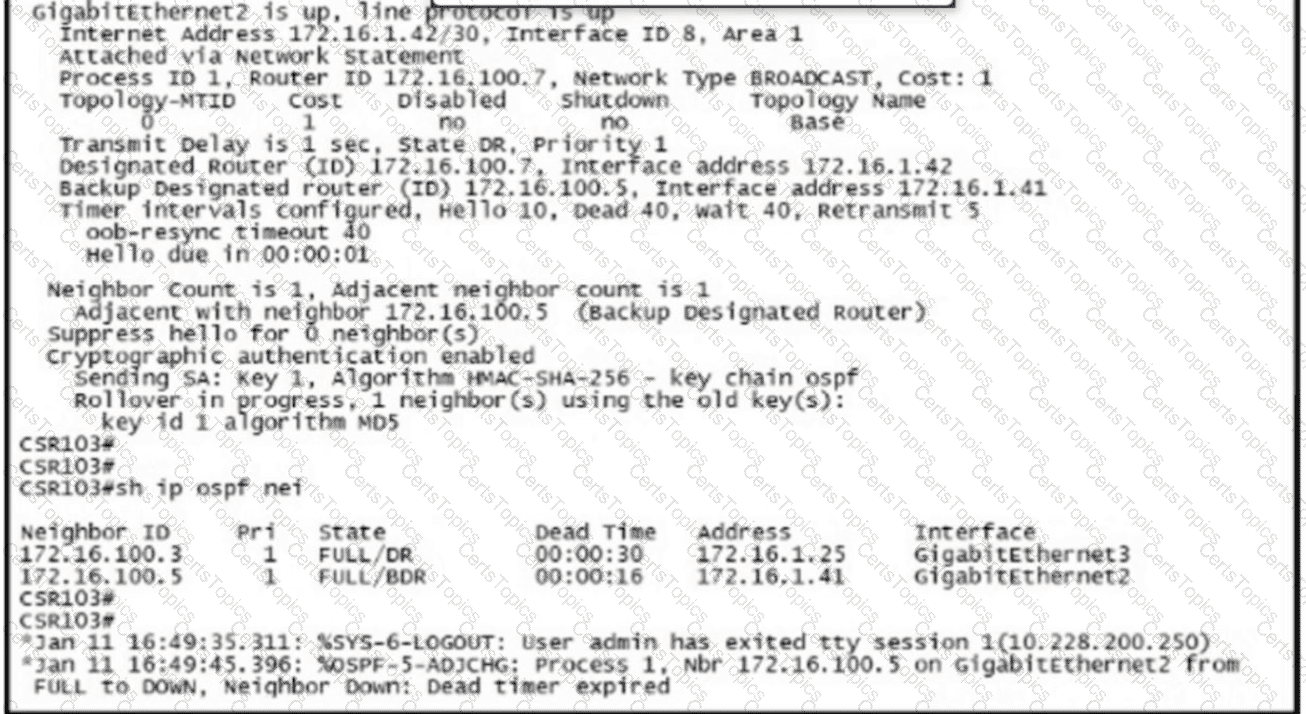
Refer to the exhibit. Which configuration resolves the issue?
A)

B)

C)
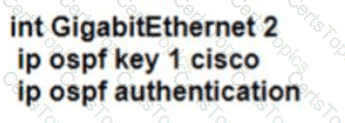
D)

The network administrator configured R1 to authenticate Telnet connections based on Cisco ISE using TACACS+. ISE has been configured with an IP address of 192.168.1.5 and with a network device pointing toward R1(192.168.1.1) with a shared secret password of Cisco123.
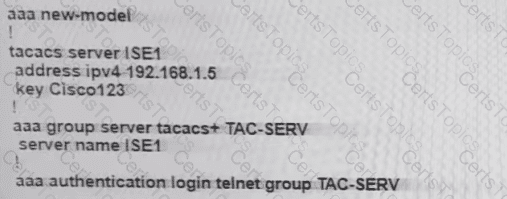
The administrator cannot authenticate to R1 based on ISE. Which configuration fixes the issue?
Which routing protocol is used by the PE router to advertise routes to a CE router without redistribution or static after removing the RD tag from the P router?
configuration on the hub router meets this requirement?
Refer to the exhibit.

An engineer must configure a LAN-to-LAN IPsec VPN between R1 and the remote router. Which IPsec
Phase 1 configuration must the engineer use for the local router?
Refer to the exhibit.
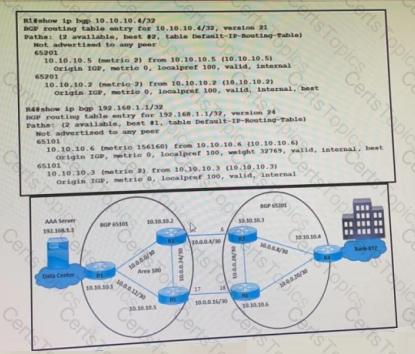
A customer reports that user traffic of bank XYZ to the AAA server is not using the primary path via the R3-R2 link. The network team observes:
No fiber is cut on links R2 and R3.
As101 and AS 201 routers established BGP peering.
Which configuration resolves the issue?
A)

B)

C)

D)

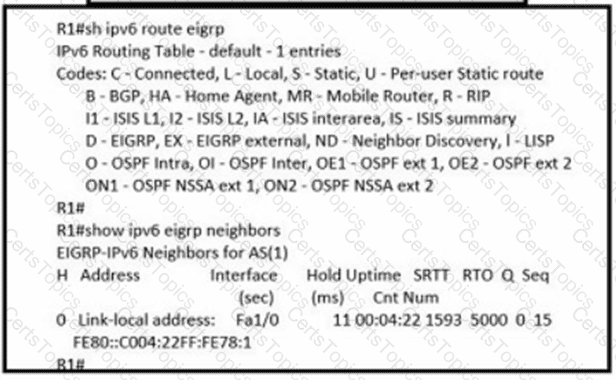
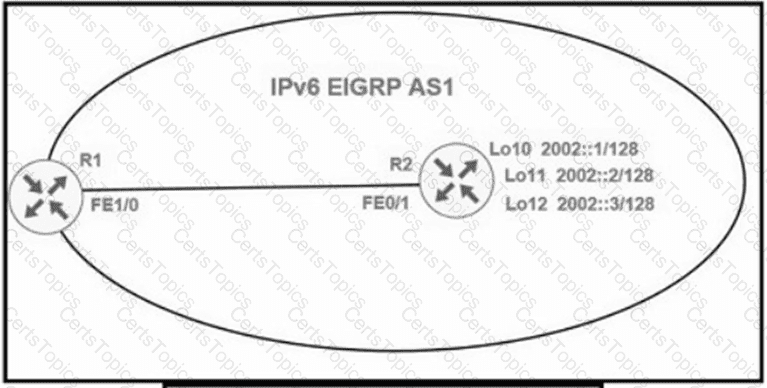

R1 cannot receive the R2 Interfaces with individual prefixes. What must be reconfigured to advertise R2 Interfaces to R1?
Refer to the Exhibit.
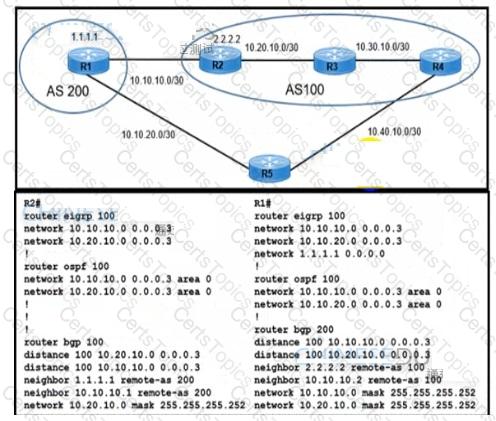
R1 and R2 use IGP protocol to route traffic between AS 100 and AS 200 despite being configured to use BGP. Which action resolves the issue and ensures the use of BGP?
What is a function of IPv6 Source Guard?
Refer to the exhibit.
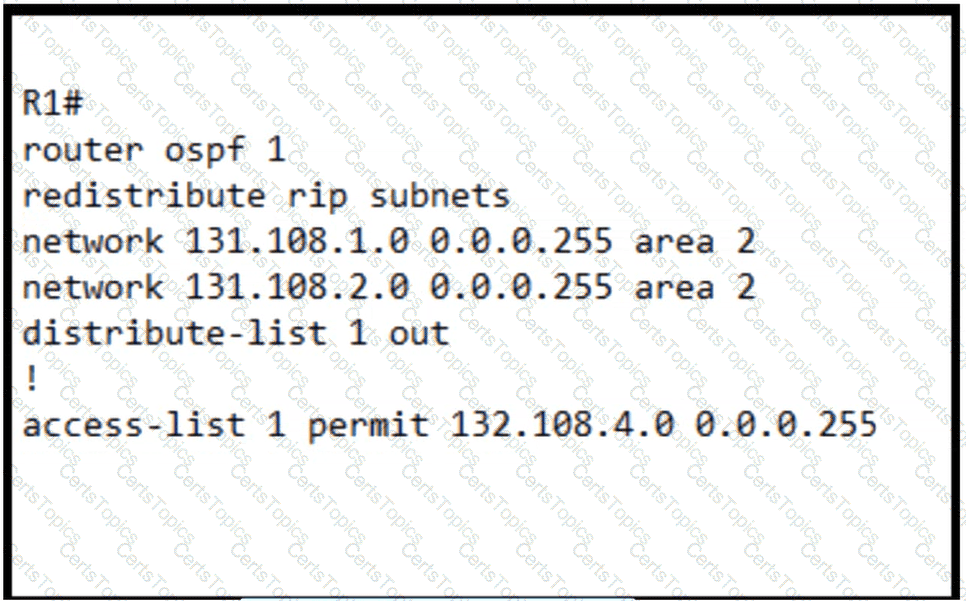
The R1 OSPF neighbor is not receiving type 5 external LSAs for 132.108.2.0/24 and 132.108.3.0/24 networks. Which configuration command resolves the issue?
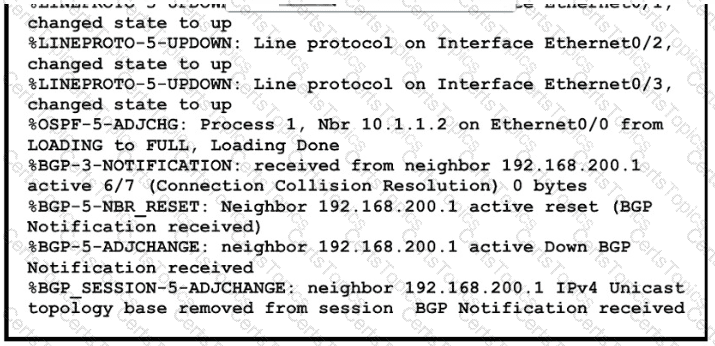
Refer to the exhibit. An engineer noticed that the router log messages do not have any information about when the event occurred. Which action should the engineer take when enabling service time stamps to improve the logging functionality at a granular level?
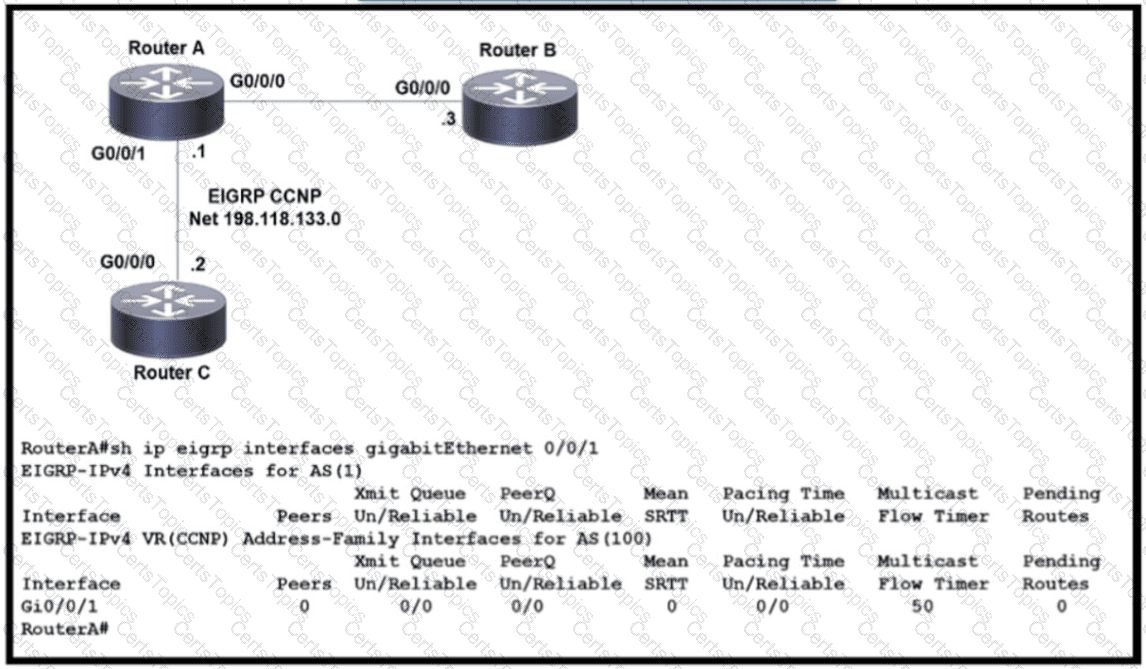
Refer to the exhibit EIGRP adjacency between router A and router C is not working as expected Which two configurations resolve the issue? (Choose two )
A)
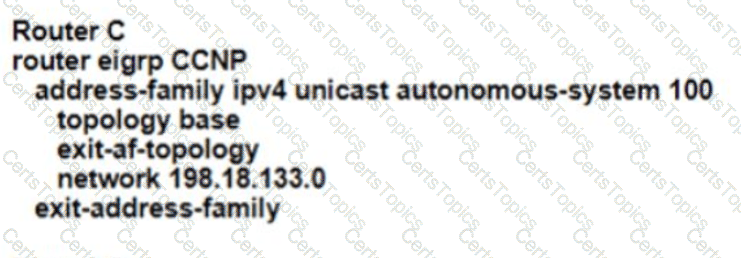
B)
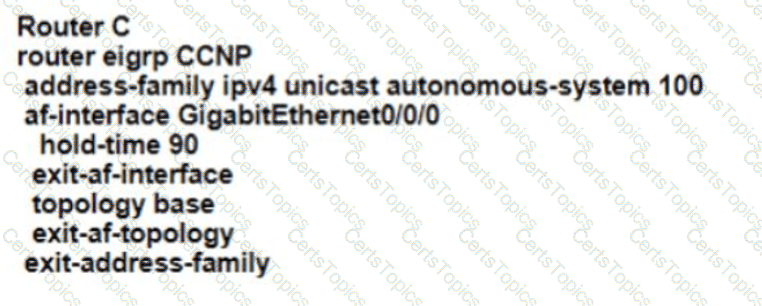
C)
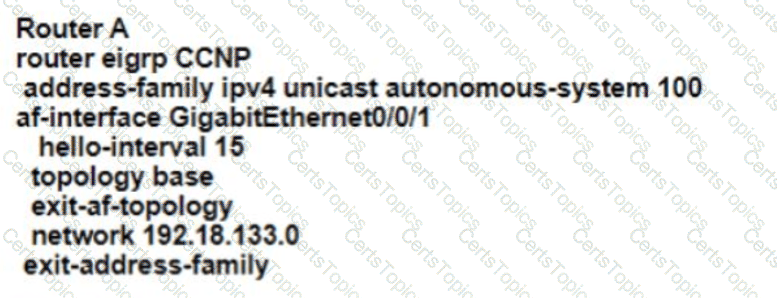
D)

E)
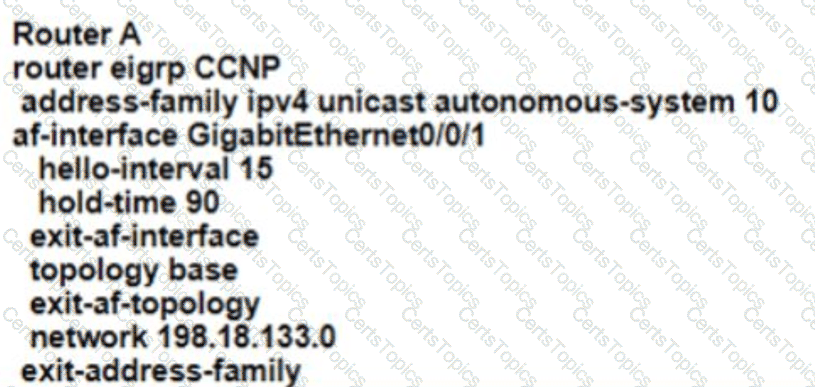
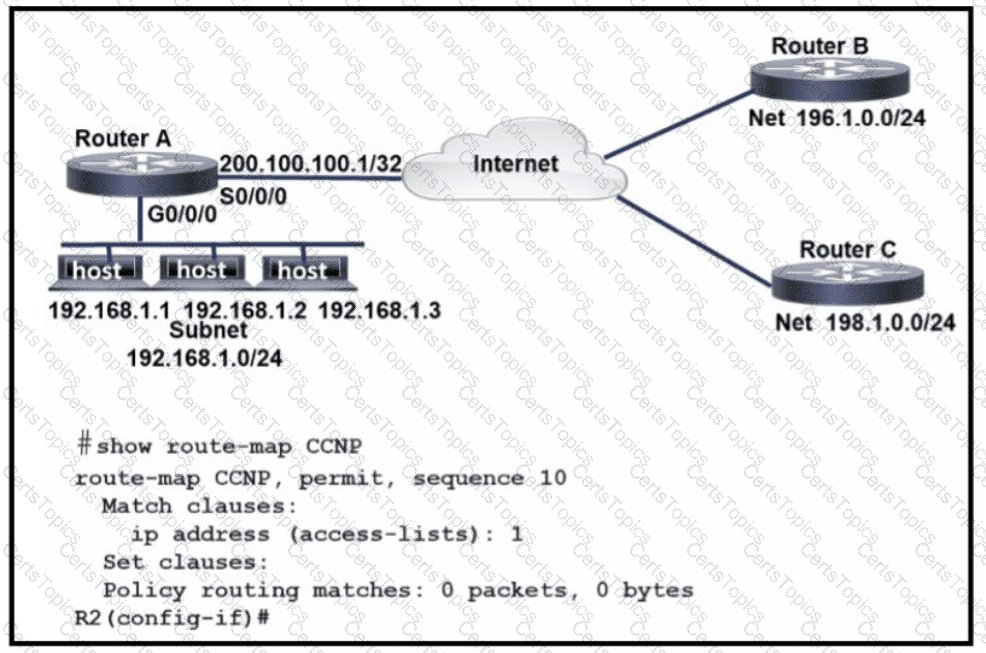
Refer to the exhibit. An engineer configures router A to mark all inside to outside traffic from network 192 168 1 0, except from host 192 168 1 1. with critical IP precedence. The policy did not work as expected Which configuration resolves the issue?
A)
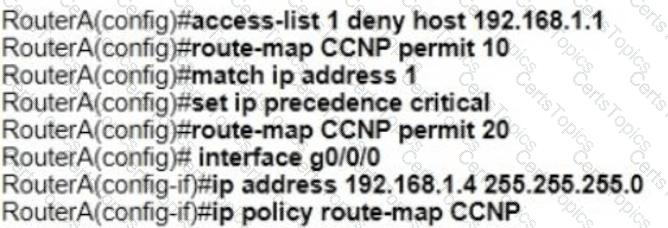
B)
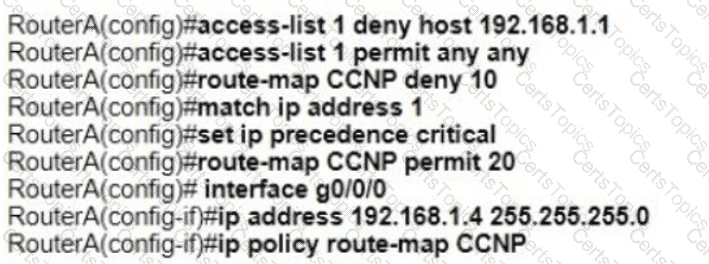
C)

D)

The network administrator configured CoPP so that all HTTP and HTTPS traffic from the administrator device located at 172.16 1.99 toward the router CPU is limited to 500 kbps. Any traffic that exceeds this limit must be dropped.
access-list 100 permit ip host 172.16.1.99 any
!
class-map CM-ADMIN
match access-group 100
!
policy-map PM-COPP
class CM-ADMIN
police 500000 conform-action transmit
!
interface E0/0
service-policy input PM-COPP
CoPP failed to capture the desired traffic and the CPU load is getting higher.
Which two configurations resolve the issue? (Choose two.)
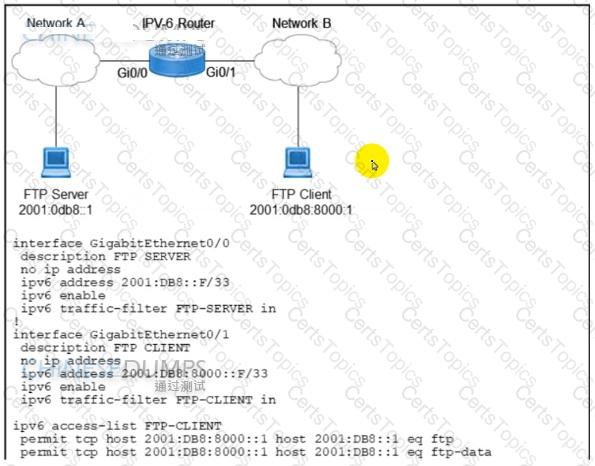

Refer to the exhibit. When an FTP client attempts to use passive FTP to connect to the FTP server, the file transfers fail Which action resolves the issue?
Refer to the exhibit.
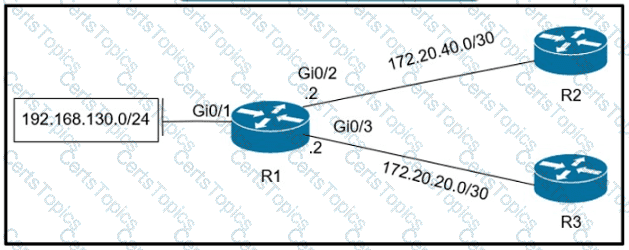
Which policy configuration on R1 forwards any traffic that is sourced from the 192 168 130 0'24 network to R2?
A)
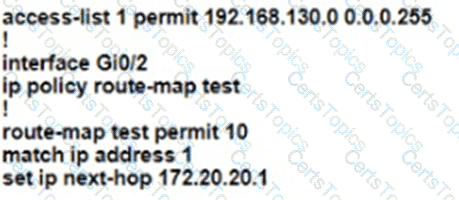
B)
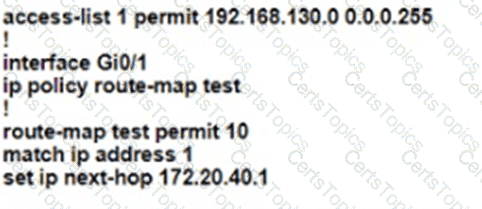
C)
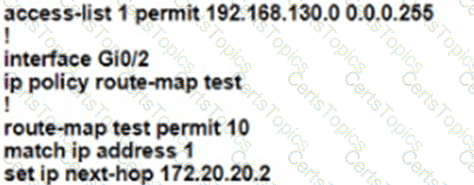
D)
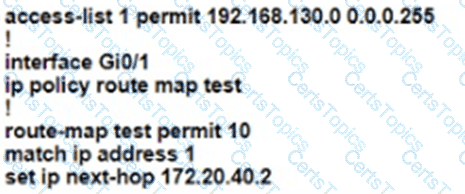
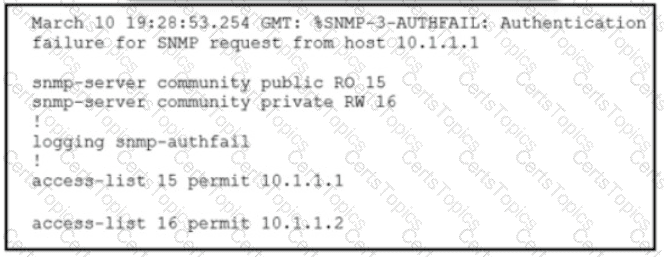
Refer to the exhibit Which action resolves the issue?
Refer to the exhibit.
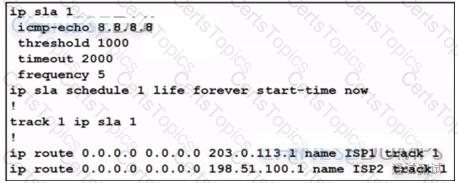
An administrator configures a router to stop using a particular default route if the DNS server 8.8.8.8 is not reachable through that route. However, this configuration did not work as desired and the default route still works even if the DNS server 8.8.8 8 is unreachable. Which two configuration changes resolve the issue? (Choose two.)

Refer to the exhibit. A network engineer is provisioning end-to-end traffic service for two different enterprise networks with these requirements
The OSPF process must differ between customers on HQ and Branch office routers, and adjacencies should come up instantly.
The enterprise networks are connected with overlapping networks between HO and a branch office
Which configuration meets the requirements for a customer site?
A
A)

B)

C)

D)

Which two technologies optimize MPLS infrastructure using bandwidth protection services when experiencing slow response7 (Choose two.)
Refer to the exhibit.

What is the result of applying this configuration?
Refer to the exhibit.
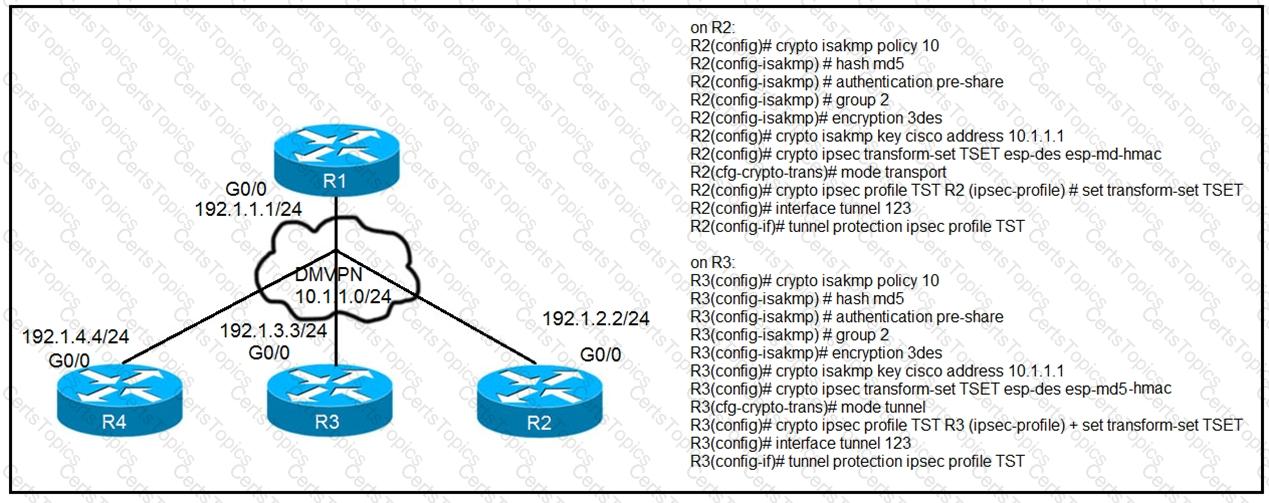
After applying IPsec, the engineer observed that the DMVPN tunnel went down, and both
spoke-to-spoke and hub were not establishing. Which two actions resolve the issue? (Choose two.)
Which command allows traffic to load-balance in an MPLS Layer 3 VPN configuration?
Drag and drop the MPLS VPN device types from me left onto the definitions on the right.

Which is statement about IPv6 inspection is true?
Refer to the exhibit.
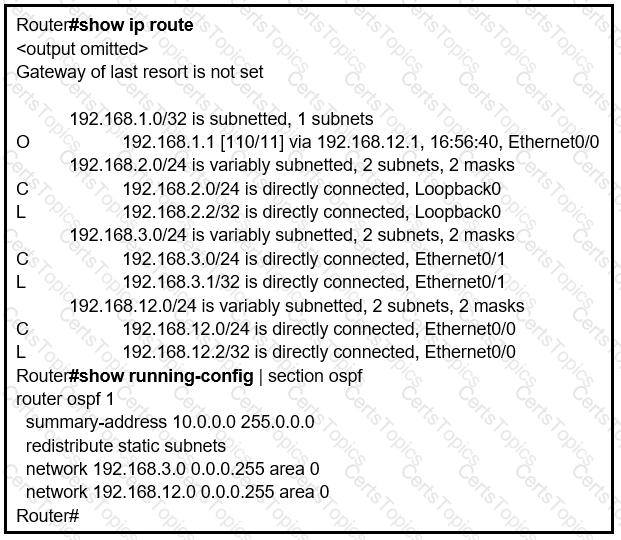
An engineer is trying to generate a summary route in OSPF for network 10.0.0.0/8, but the
summary route does not show up in the routing table. Why is the summary route missing?
Refer to the exhibit.

Which configuration configures a policy on R1 to forward any traffic that is sourced from
the 192.168.130.0/24 network to R2?
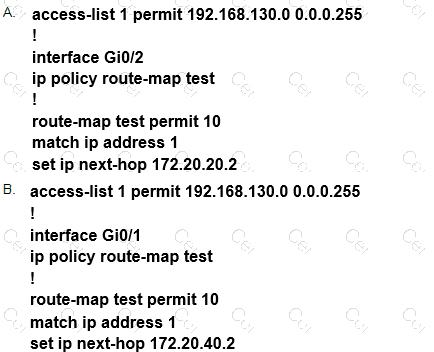
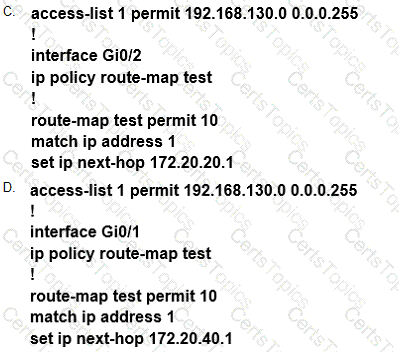
Refer to the exhibit.
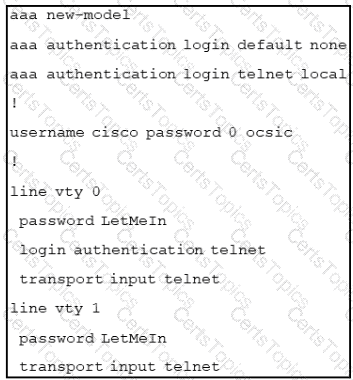
Drag and drop the credentials from the left onto the remote login information on the right to resolve a failed login attempt to vtys. Not all credentials are uf SLA by defining frequency and schedulingsed
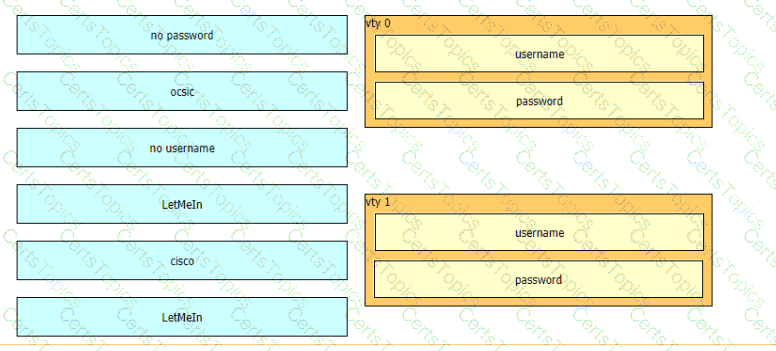
Refer to the exhibit.
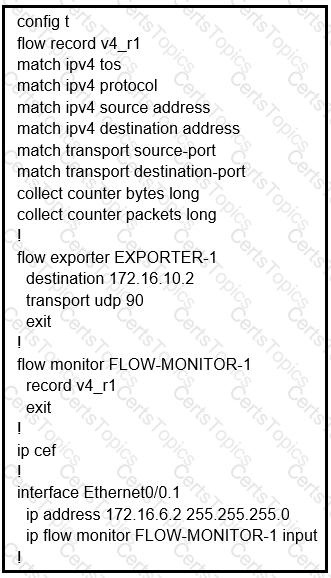
Why is the remote NetFlow server failing to receive the NetFlow data?
While troubleshooting connectivity issues to a router, these details are noticed:
Standard pings to all router interfaces, including loopbacks, are successful.
Data traffic is unaffected.
SNMP connectivity is intermittent.
SSH is either slow or disconnects frequently.
Which command must be configured first to troubleshoot this issue?
Refer to the exhibit.
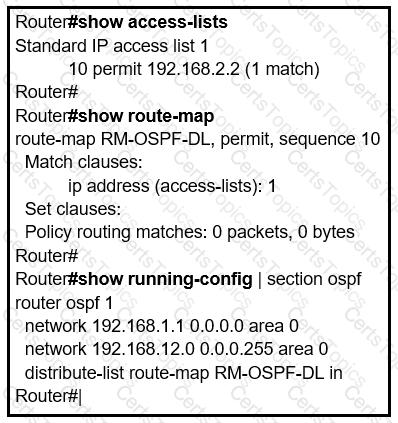
An engineer is trying to block the route to 192.168.2.2 from the routing table by using the
configuration that is shown. The route is still present in the routing table as an OSPF route. Which action blocks the route?
While working with software images, an engineer observes that Cisco DNA Center cannot upload its software image directly from the device. Why is the image not uploading?
Refer to the exhibit.
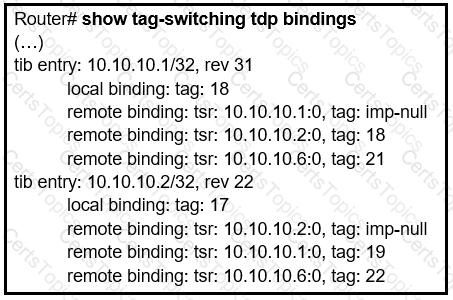
What does the imp-null tag represent in the MPLS VPN cloud?
Refer to the exhibit.
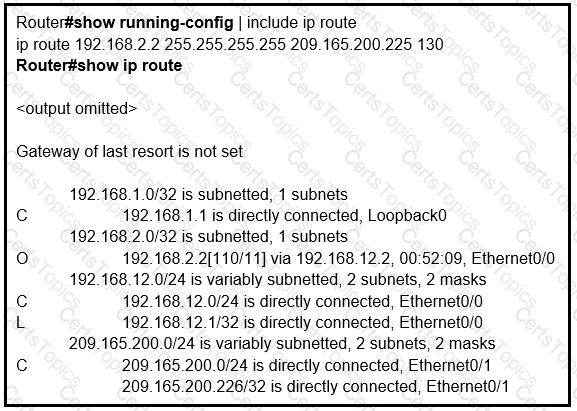
An engineer configures a static route on a router, but when the engineer checks the route
to the destination, a different next hop is chosen. What is the reason for this?
Refer to the exhibit.
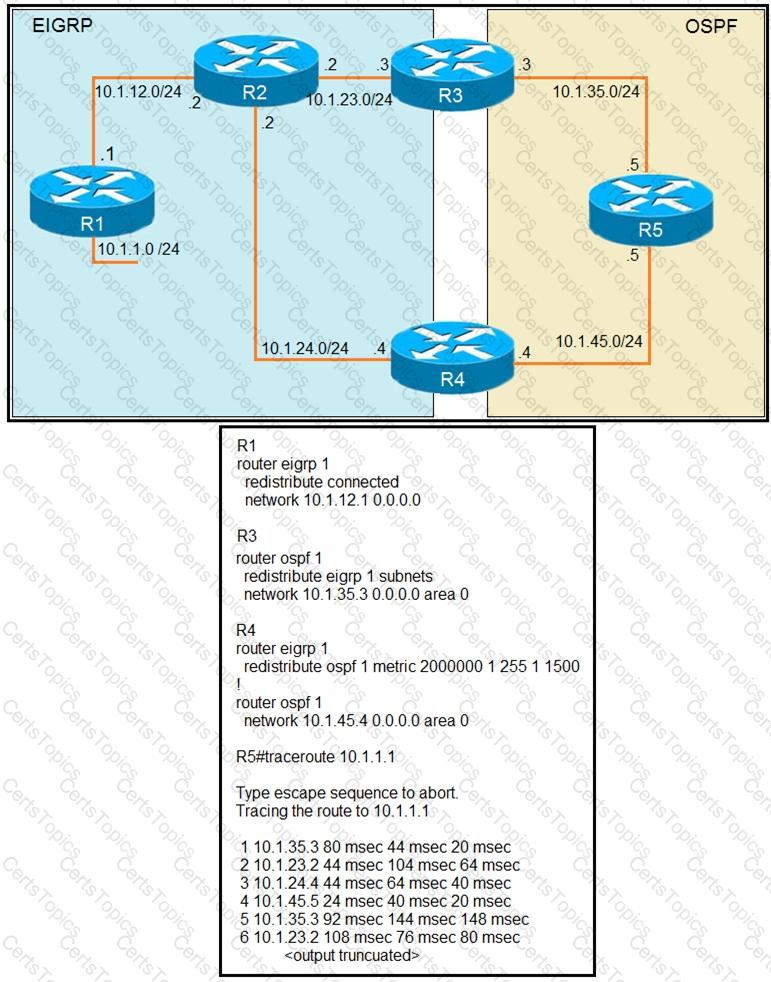
The output of the trace route from R5 shows a loop in the network. Which configuration
prevents this loop?
A)
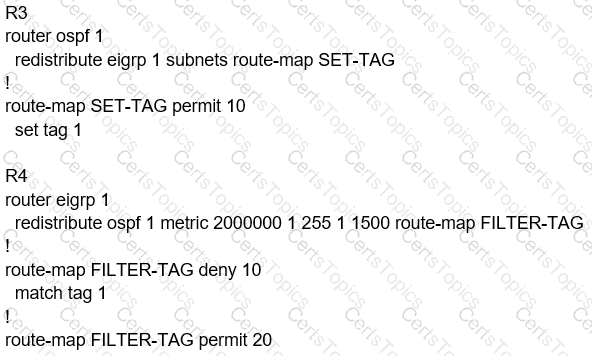
B)
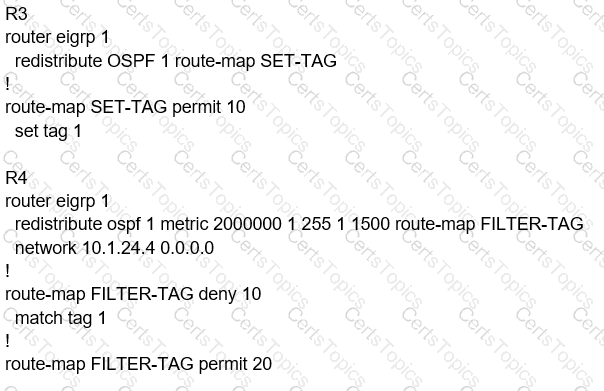
C)
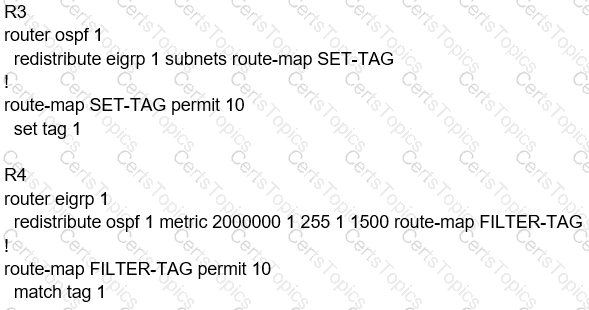
D)
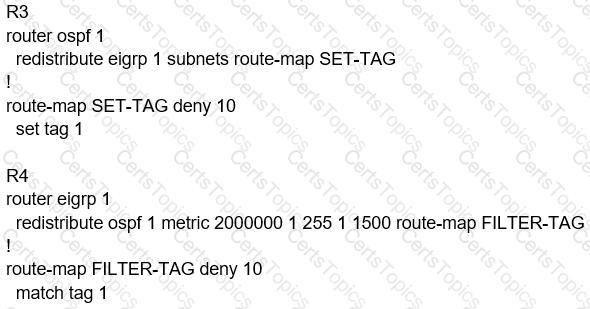
Which label operations are performed by a label edge router?
Which protocol is used to determine the NBMA address on the other end of a tunnel when mGRE is used?
Which two protocols can cause TCP starvation? (Choose two)
Refer to the exhibit.
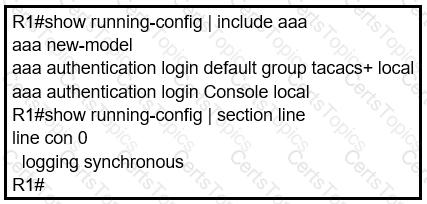
An engineer is trying to configure local authentication on the console line, but the device is trying to authenticate using TACACS+. Which action produces the desired configuration?
Refer to the exhibit.
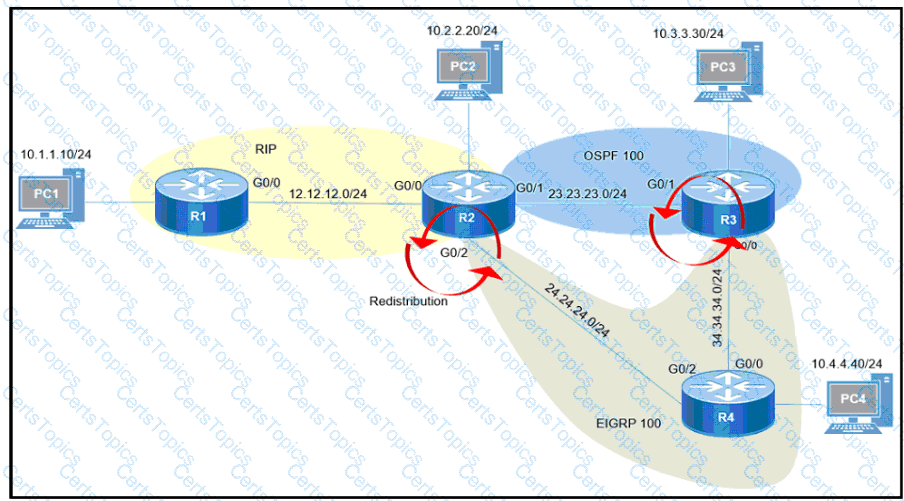
Redistribution is enabled between the routing protocols, and nowPC2 PC3, and PC4 cannot reach PC1. What are the two solutions to fix the problem? (Choose two.)
Refer to the exhibit.

Why is user authentication being rejected?
What is the output of the following command:
show ip vrf
Which method changes the forwarding decision that a router makes without first changing the routing table or influencing the IP data plane?
Refer to the exhibit.
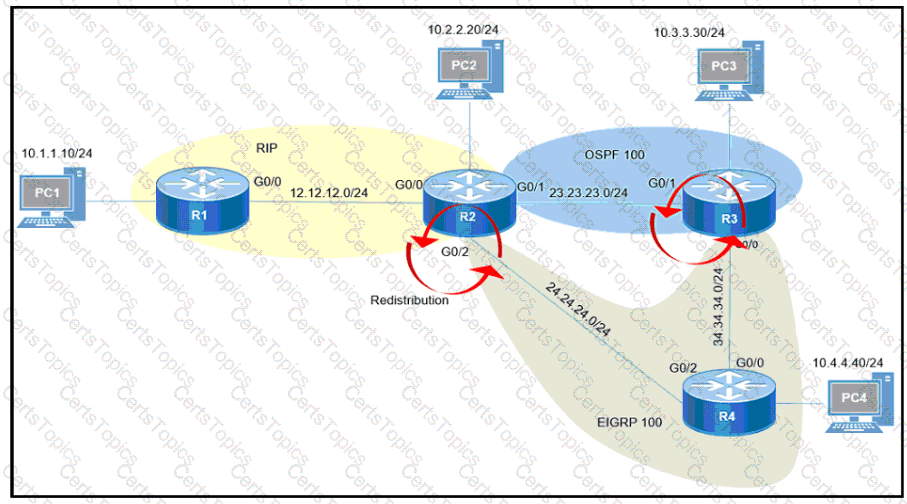
After redistribution is enabled between the routing protocols; PC2, PC3, and PC4 cannot reach PC1. Which action can the engineer take to solve the issue so that all the PCs are reachable?
Refer to the exhibit.
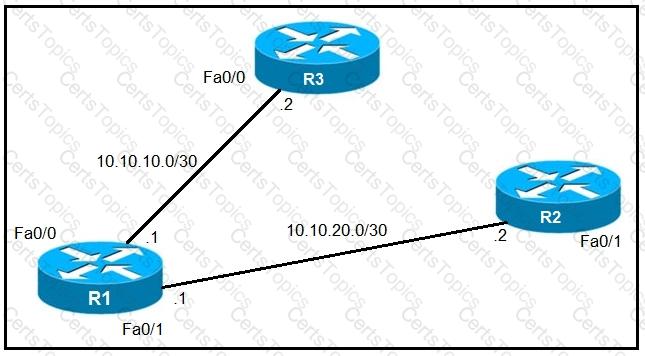
An IP SLA was configured on router R1 that allows the default route to be modified in the event that Fa0/0 loses reachability with the router R3 Fa0/0 interface. The route has changed to flow through
router R2. Which debug command is used to troubleshoot this issue?
After some changes in the routing policy, it is noticed that the router in AS 45123 is being used as a transit AS router for several service provides. Which configuration ensures that the branch router in AS 45123 advertises only the local networks to all SP neighbors?
A)

B)

C)

D)

Drag and drop the operations from the left onto the locations where the operations are performed on the right.
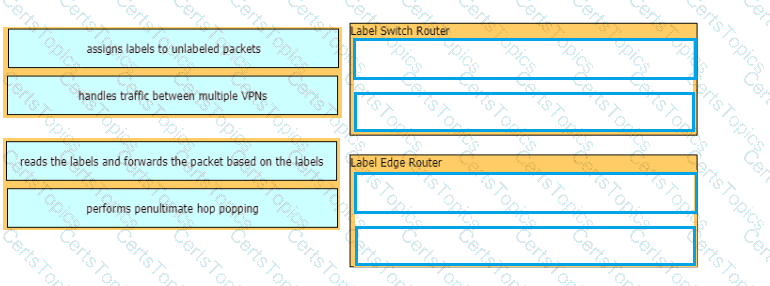
Refer to the following output:
Router#show ip nhrp detail
10.1.1.2/8 via 10.2.1.2, Tunnel1 created 00:00:12, expire 01:59:47
TypE. dynamic, Flags: authoritative unique nat registered used
NBMA address: 10.12.1.2
What does the authoritative flag mean in regards to the NHRP information?
An engineer is configuring a network and needs packets to be forwarded to an interface for any destination address that is not in the routing table. What should be configured to accomplish this task?
Which transport layer protocol is used to form LDP sessions?
Refer to the exhibit.
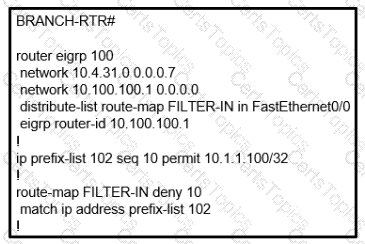
A junior engineer updated a branch router configuration. Immediately after the change, the engineer receives calls from the help desk that branch personnel cannot reach any network destinations. Which configuration restores service and continues to block 10.1.1.100/32?
Refer to the exhibit.
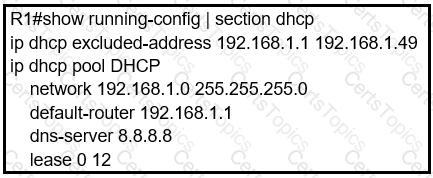
Users report that IP addresses cannot be acquired from the DHCP server. The DHCP
server is configured as shown. About 300 total nonconcurrent users are using this DHCP server, but none of them are active for more than two hours per day. Which action fixes the issue within the current resources?
Refer to the exhibit.

The ACL is placed on the inbound Gigabit 0/1 interface of the router. Host
192.168.10.10cannot SSH to host 192.168.100.10 even though the flow is permitted. Which action
resolves the issue without opening full access to this router?
Refer to the exhibit.
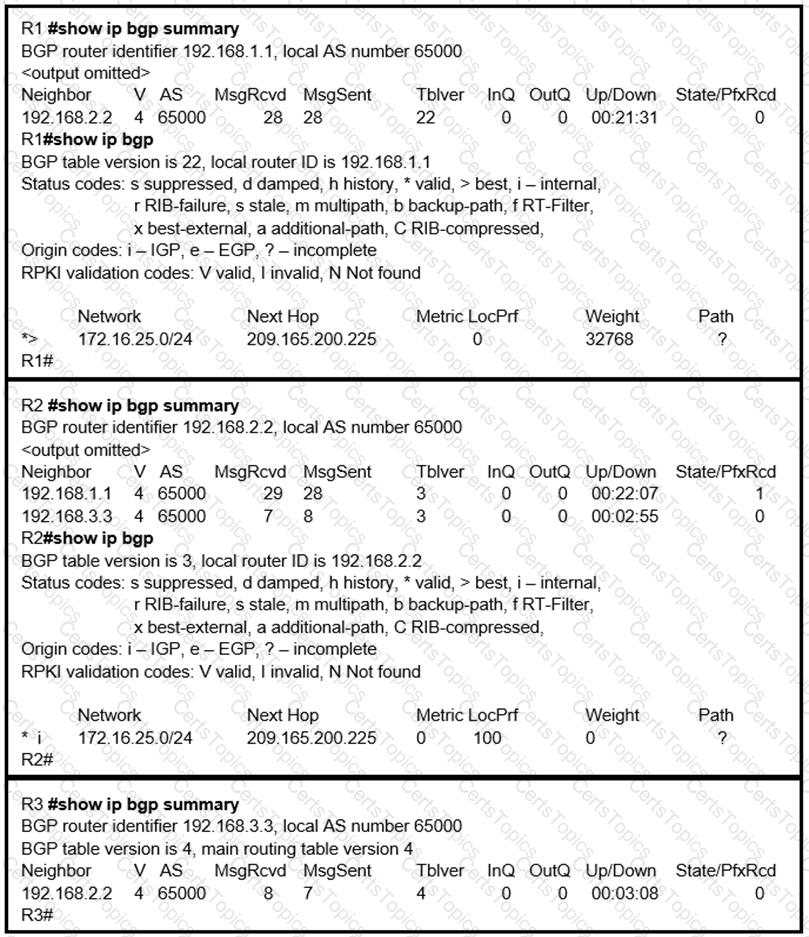
R2 is a route reflector, and R1 and R3 are route reflector clients. The route reflector learns the route to 172.16.25.0/24 from R1, but it does not advertise to R3. What is the reason the route is not advertised?
Refer to the exhibit.
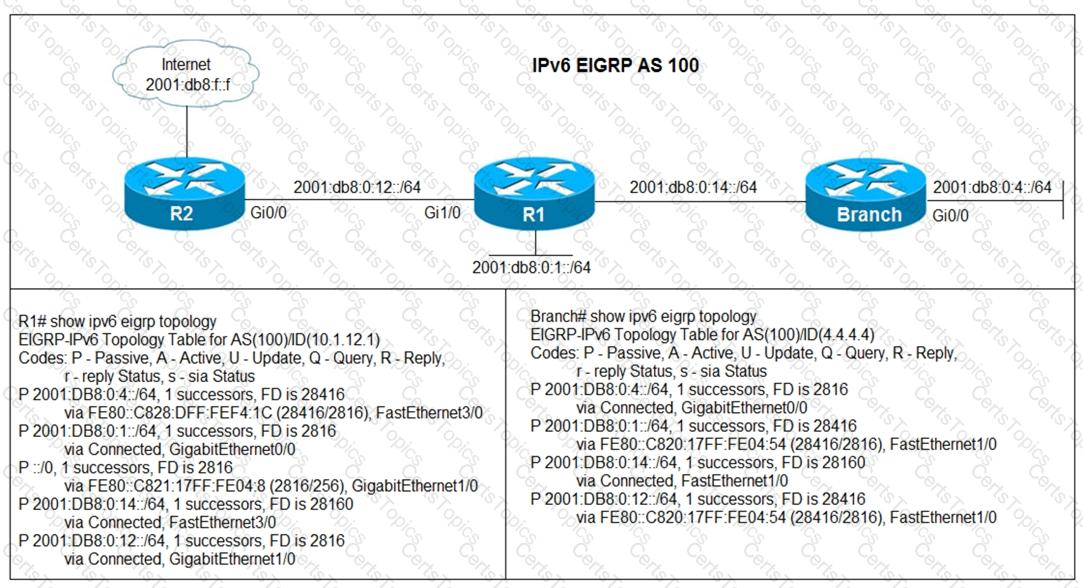
Users in the branch network of 2001:db8:0:4::/64 report that they cannot access the Internet. Which command is issued in IPv6 router EIGRP 100 configuration mode to solve this issue?
What is a function of IPv6 ND inspection?
Refer to the exhibit.

Which statement about R1 is true?
When provisioning a device in Cisco DNA Center, the engineer sees the error message “Cannot select the device. Not compatible with template”.
What is the reason for the error?
Which option is the best for protecting CPU utilization on a device?
Drag and drop the OSPF adjacency states from the left onto the correct descriptions on the right.
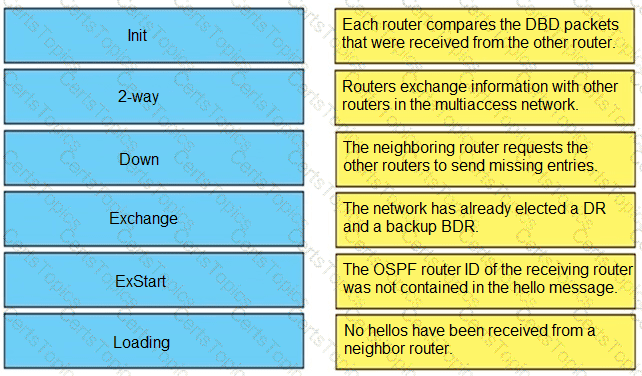
Which command is used to check IP SLA when an interface is suspected to receive lots of traffic with options?
Refer to the exhibit.
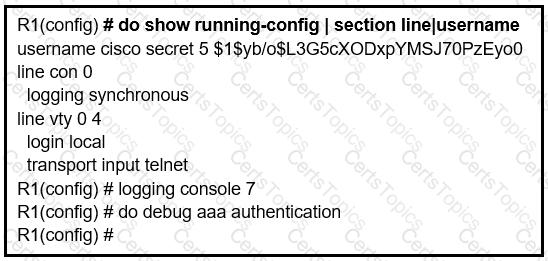
An administrator that is connected to the console does not see debug messages when
remote users log in. Which action ensures that debug messages are displayed for remote logins?
Refer to the exhibit.

Which routes from OSPF process 5 are redistributed into EIGRP?
Refer to the exhibit.
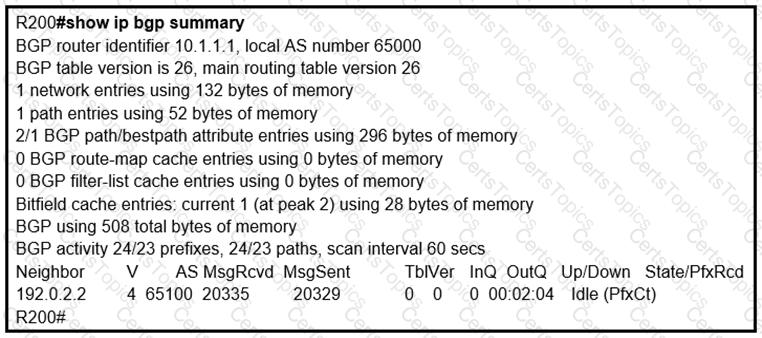
In which circumstance does the BGP neighbor remain in the idle condition?
Which protocol does VRF-Lite support?
Refer to the exhibits.
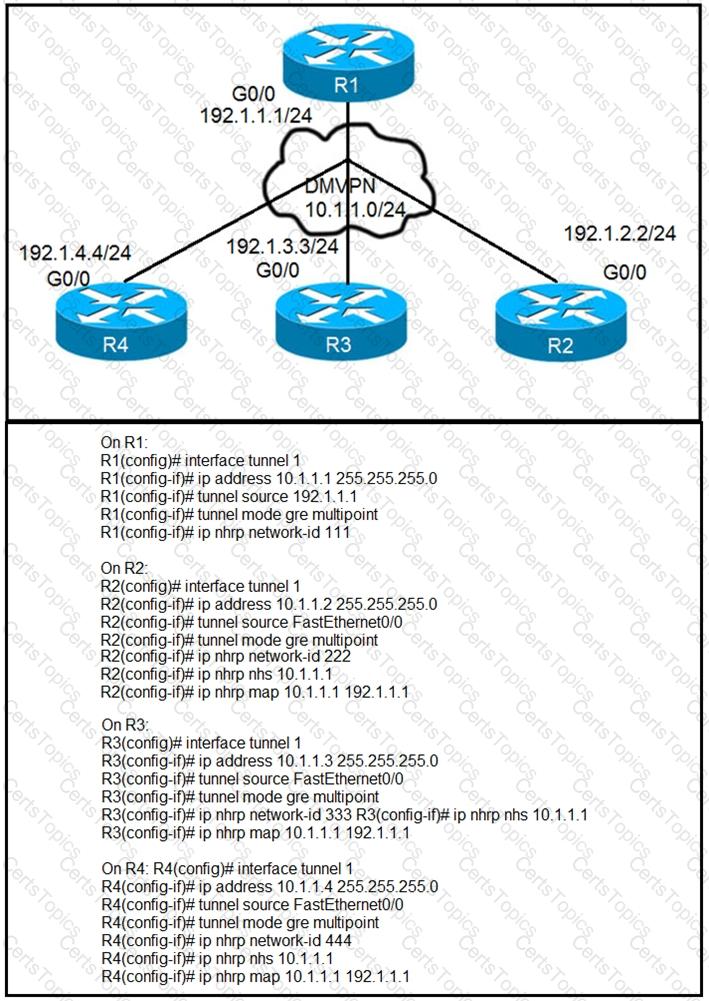
Phase-3 tunnels cannot be established between spoke-to-spoke in DMVPN. Which two
commands are missing? (Choose two.)
Refer the exhibit.
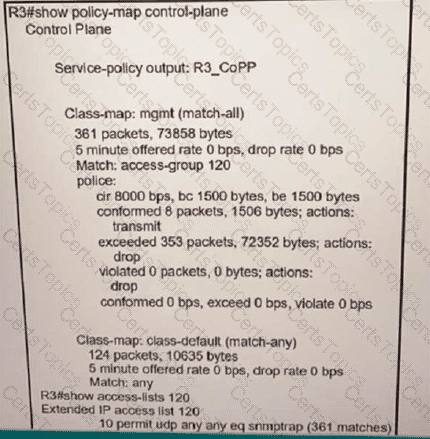
Which action resolves intermittent connectivity observed with the SNMP trap
packets?
Which two methods use IPsec to provide secure connectivity from the branch office to the headquarters office? (Choose two.)
During the maintenance window an administrator accidentally deleted the Telnet-related
configuration that permits a Telnet connection from the inside network (Eth0/0) to the outside of the networking between Friday – Sunday night hours only. Which configuration resolves the issue?
A)
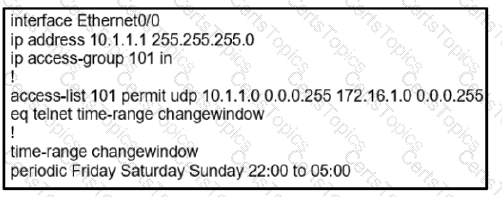
B)
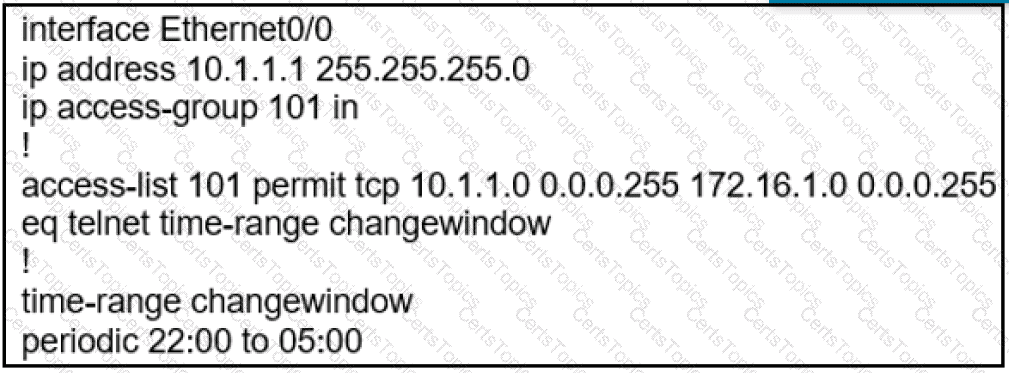
C)
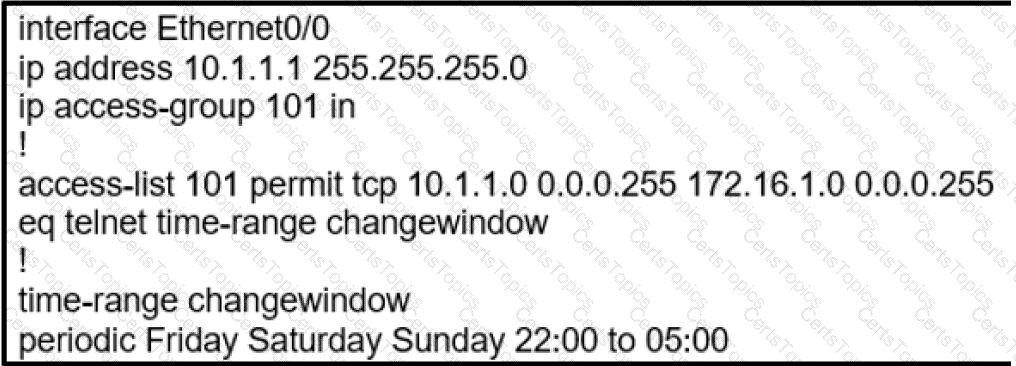
D)

Which statement about IPv6 ND inspection is true?
Drag and drop the MPLS VPN concepts from the left onto the correct descriptions on the right.
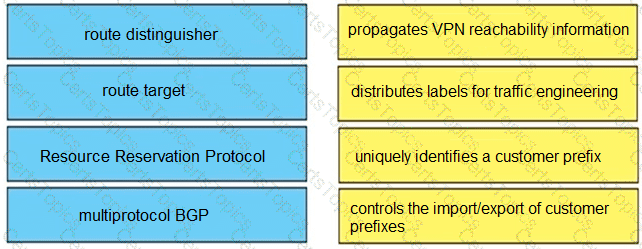
Which security feature can protect DMVPN tunnels?
Refer to the exhibit.
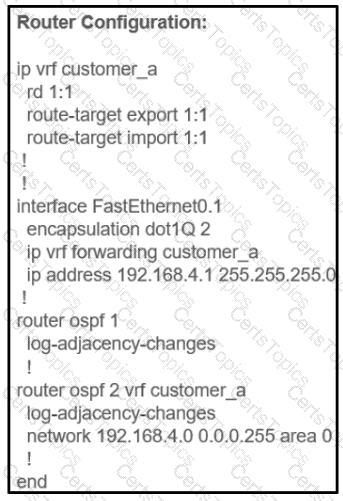
The network administrator configured VRF lite for customer A. The technician at the remote site misconfigured VRF on the router. Which configuration will resolve connectivity for both sites of customer_a?
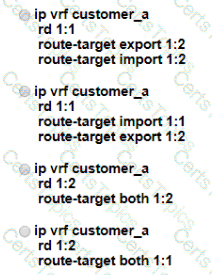
Refer to the exhibit.
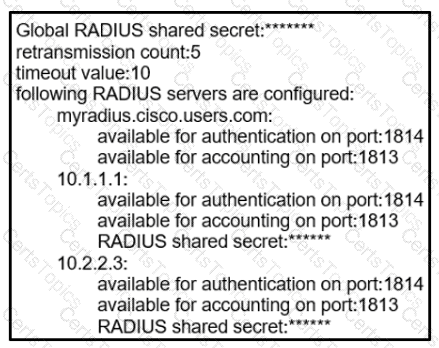
AAA server 10.1.1.1 is configured with the default authentication and accounting settings, but the switch cannot communicate with the server Which action resolves this issue?
Refer to the exhibit.
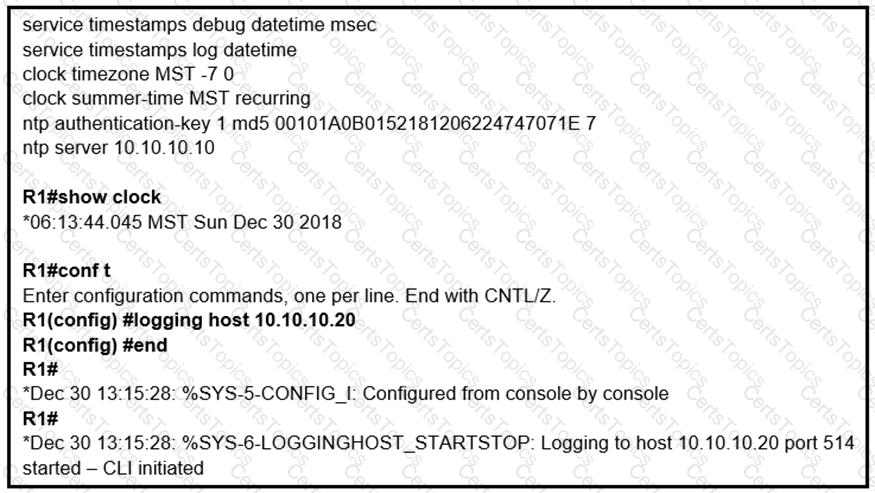
An administrator noticed that after a change was made on R1, the timestamps on the system logs did not match the clock. What is the reason for this error?
Refer to the exhibit.
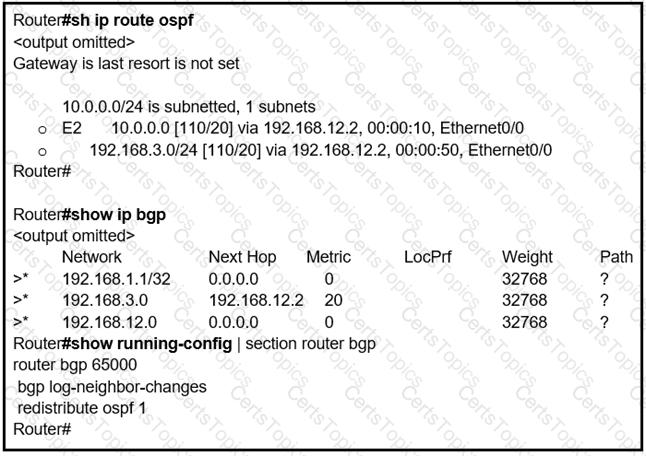
An engineer is trying to redistribute OSPF to BGP, but not all of the routes are
redistributed. What is the reason for this issue?
Which statement about route distinguishers in an MPLS network is true?
Refer to the exhibit.

Which configuration denies Telnet traffic to router 2 from 198A:0:200C::1/64?
A)

B)

C)

D)

An engineer configured a leak-map command to summarize EIGRP routes and advertise specifically loopback 0 with an IP of 10.1.1.1.255.255.255.252 along with the summary route. After finishing configuration, the customer complained not receiving summary route with specific loopback address. Which two configurations will fix it? (Choose two.)

Which two statements about VRF-Lite configurations are true? (Choose two.)
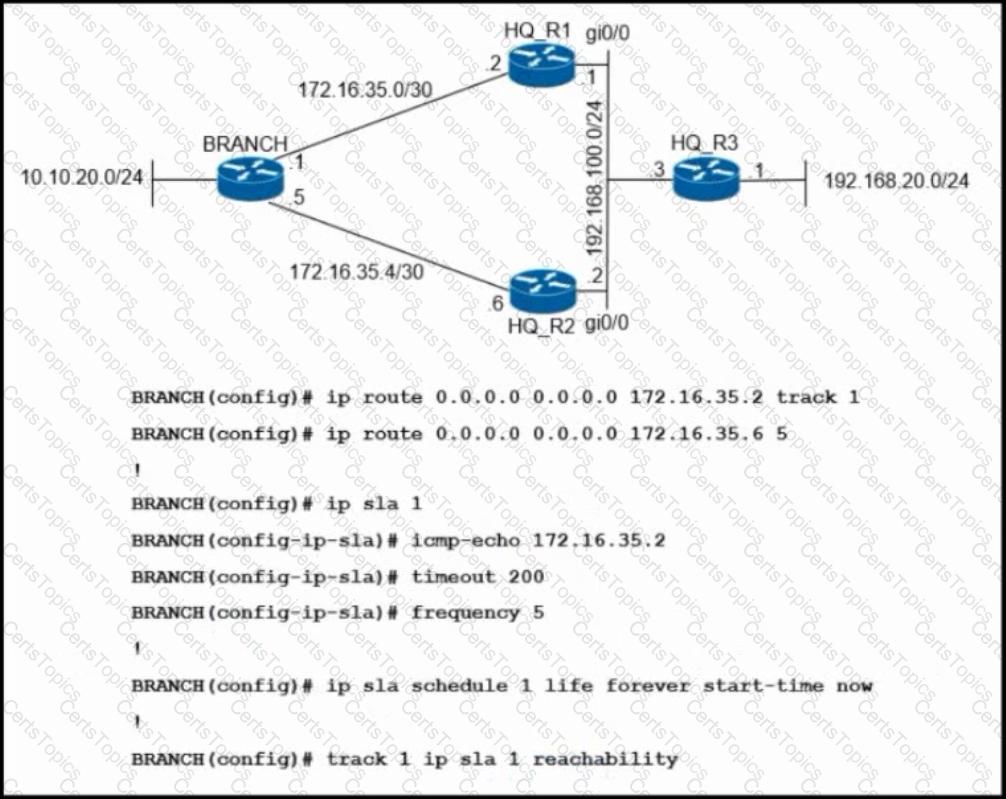
Refer to the exhibit. An engineer has successfully set up a floating static route from the BRANCH router to the HQ network using HQ_R1 as the primary default gateway When the g0/0 goes down on HQ_R1, the branch network cannot reach the HQ network 192.168.20.0/24. Which set of configurations resolves the issue?
Refer to the exhibit.
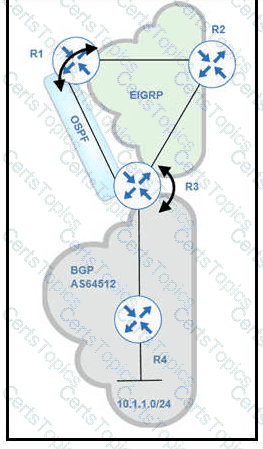
BGP and EIGRP are mutually redistributed on R3, and EIGRP and OSPF are mutually redistributed on R1. Users report packet loss and interruption of service to applications hosted onthe 10.1.1.0724 prefix. An engineer tested the link from R3 to R4 with no packet loss present but has noticed frequent routing changes on R3 when running the debug ip route command. Which action stabilizes the service?
Refer to the exhibit.

Which two actions should be taken to access the server? (Choose two.)
Which feature drops packets if the source address is not found in the snooping table?
What statement about route distinguishes in an MPLS network is true?
Refer to the exhibit.
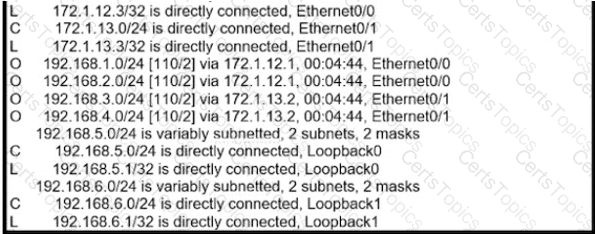
SanFrancisco and Boston routers are choosing slower links to reach each other despite the direct links being up Which configuration fixes the issue?
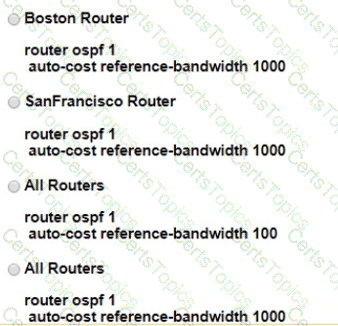
What does IPv6 Source Guard utilize to determine if IPv6 source addresses should be forwarded?
Refer to the exhibit.
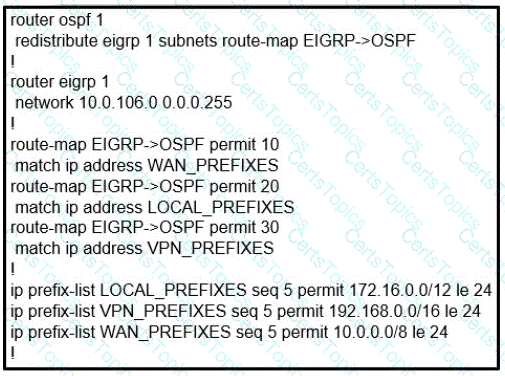
The network administrator configured redistribution on an ASBR to reach to all WAN networks but failed Which action resolves the issue?
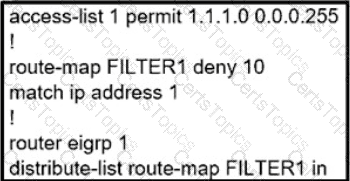
Refer to the exhibit. Which action restores the routes from neighbors while still filtering 1.1.1.0/24?
Refer to the exhibit.
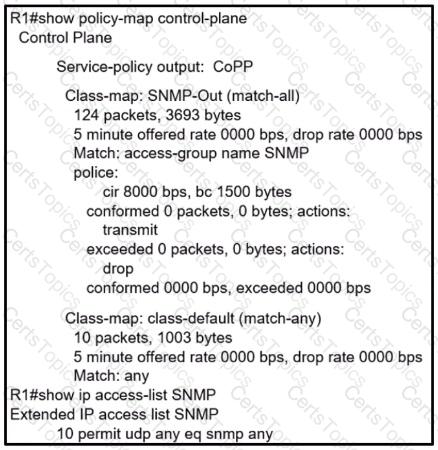
R1 is being monitored using SNMP and monitoring devices are getting only partial information. What action should be taken to resolve this issue?
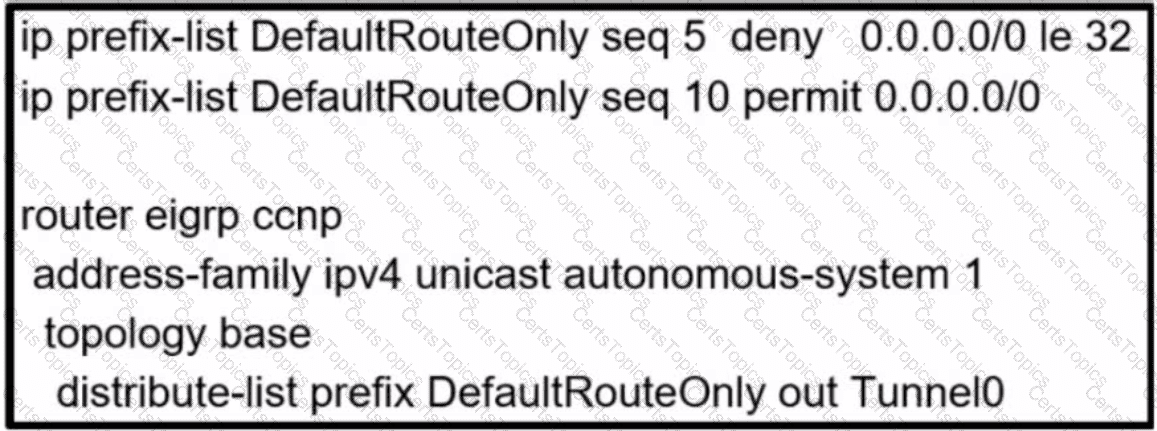
Refer to the exhibit. The administrator configured route advertisement to a remote low resources router to use only the default route to reach any network but failed. Which action resolves this issue?
An engineer configured SNMP notifications sent to the management server using authentication and encrypting data with DES. An error in the response PDU is received as "UNKNOWNUSERNAME. WRONGDIGEST". Which action resolves the issue?
Refer to the exhibit.
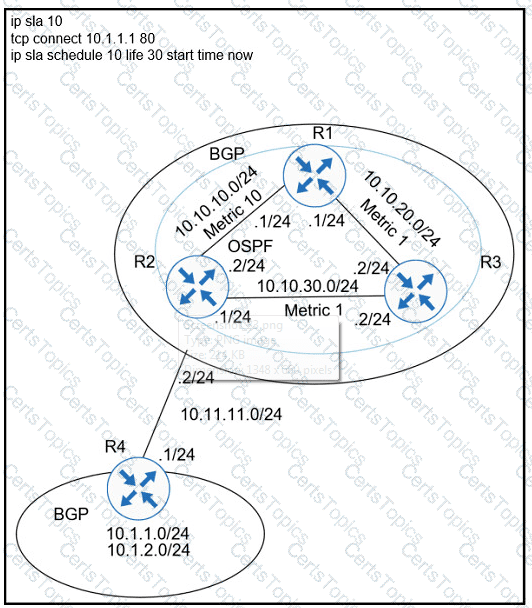
A user has set up an IP SLA probe to test if a non-SLA host web server on IP address 10.1.1.1 accepts HTTP sessions prior to deployment. The probe is failing. Which action should the network administrator recommend for the probe to succeed?
Refer to the exhibit.
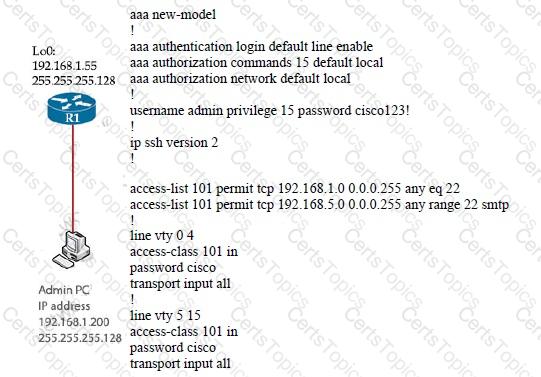
The administrator successfully logs into R1 but cannot access privileged mode commands. What should be configured to resolve the issue?
Refer to the exhibit.

PC-2 failed to establish a Telnet connection to the terminal server. Which configuration resolves the issue?

Refer to the exhibit.
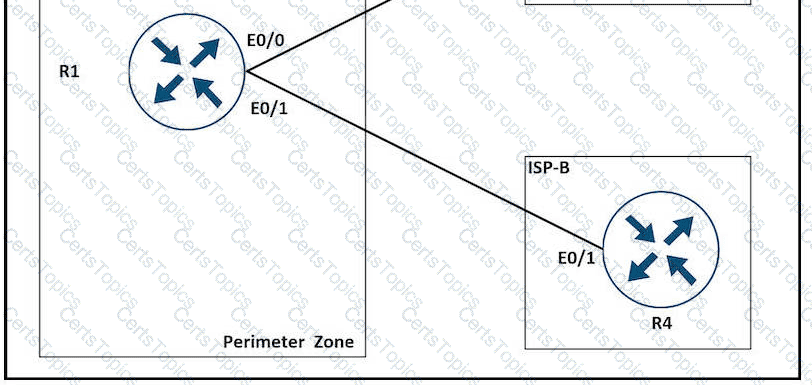
A network is under a cyberattack. A network engineer connected to R1 by SSH and enabled the terminal monitor via SSH session to find the source and destination of the attack. The session was flooded with messages, which made it impossible for the engineer to troubleshoot the issue. Which command resolves this issue on R1?
Clients on ALS2 receive IPv4 and IPv6 addresses but clients on ALS1 receive only IPv4 addresses and not IPv6 addresses. Which action on DSW1 allows clients on ALS1 to receive IPv6 addresses?
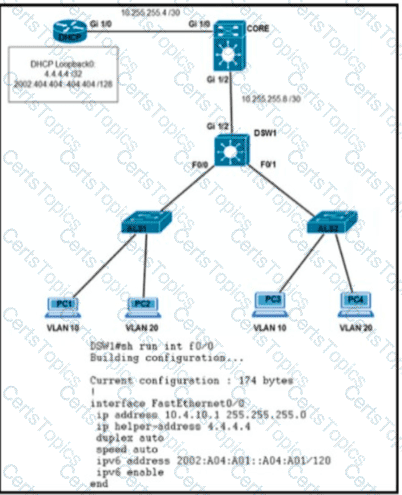
An engineer must configure a Cisco router to initiate secure connections from the router to other devices in the network but kept failing. Which two actions resolve the issue? (Choose two.)
Which IGPs are supported by the MPLS LDP autoconfiguration feature?
Refer to the exhibit.
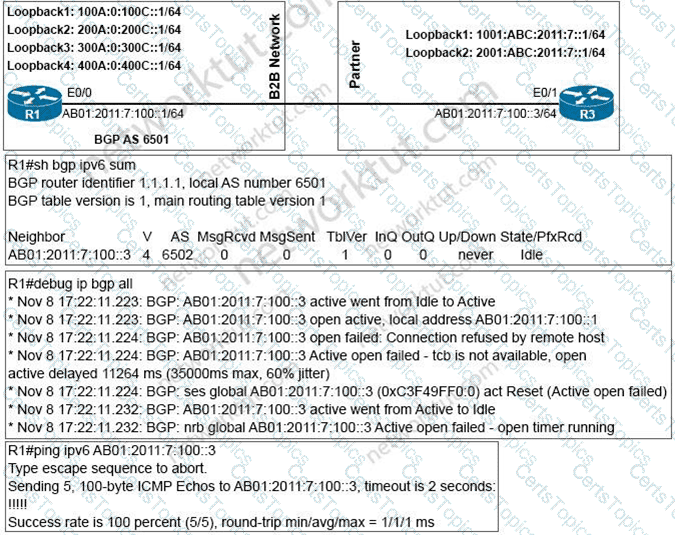

An engineer configured BGP between routers R1 and R3 The BOP peers cannot establish neighbor adjacency to be able to exchange routes. Which configuration resolves this issue?
Which configuration feature should be used to block rogue router advertisements instead of using the IPv6 Router Advertisement Guard feature?
What are two functions of IPv6 Source Guard? (Choose two.)
An engineer configured two routers connected to two different service providers using BGP with default attributes. One of the links is presenting high delay, which causes slowness in the network. Which BGP attribute must the engineer configure to avoid using the high-delay ISP link if the second ISP link is up?
Refer to the exhibit.
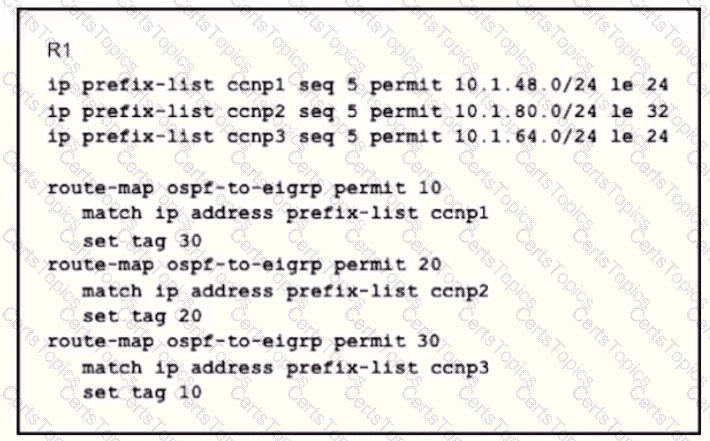
An engineer wanted to set a tag of 30 to route 10 1.80.65/32 but it failed How is the issue fixed?
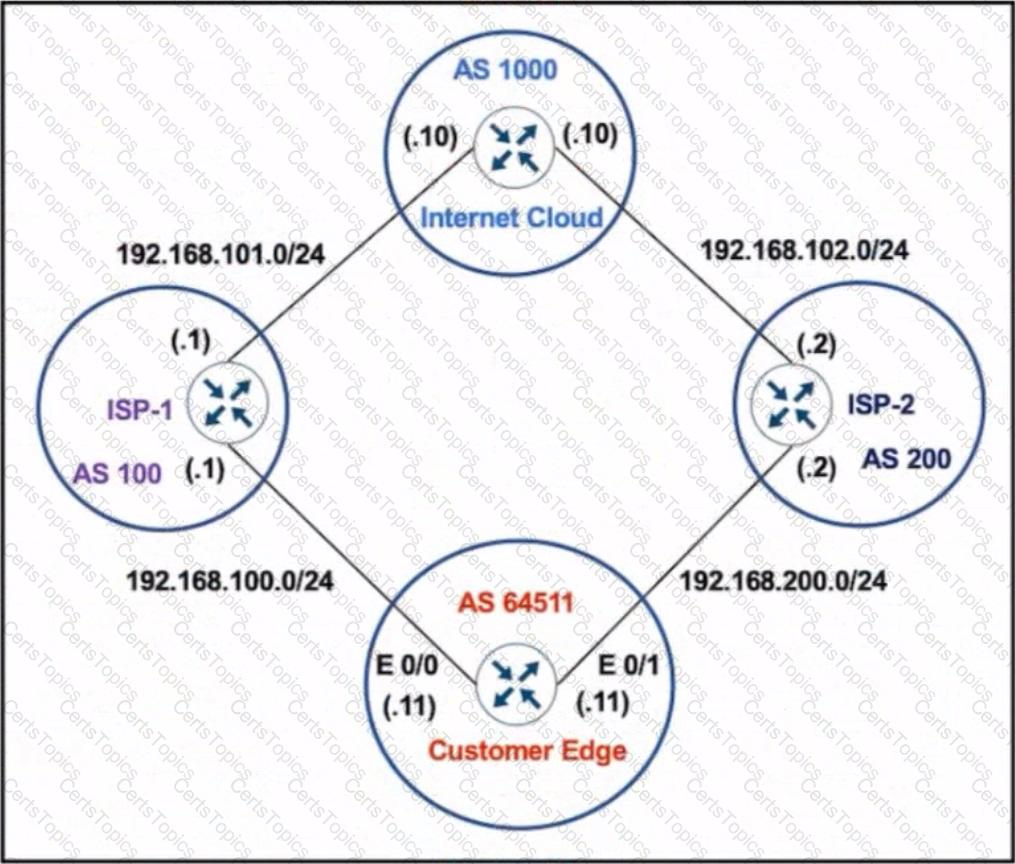
Refer to the exhibit. The network administrator has configured the Customer Edge router (AS 64511) to send only summarized routes toward ISP-1 (AS 100) and ISP-2 (AS 200).
router bgp 64511
network 172.16.20.0 mask 255.255.255.0
network 172.16.21.0 mask 255.255.255.0
network 172.16.22.0 mask 255.255.255.0
network 172.16.23.0 mask 255.255.255.0
aggregate-address 172.16.20.0 255.255.252.0
After this configuration. ISP-1 and ISP-2 continue to receive the specific routes and the summary route. Which configuration resolves the issue?
Exhibit:
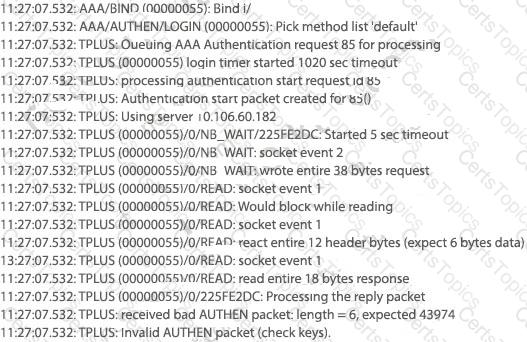
Which action resolves the authentication problem?
Exhibit:
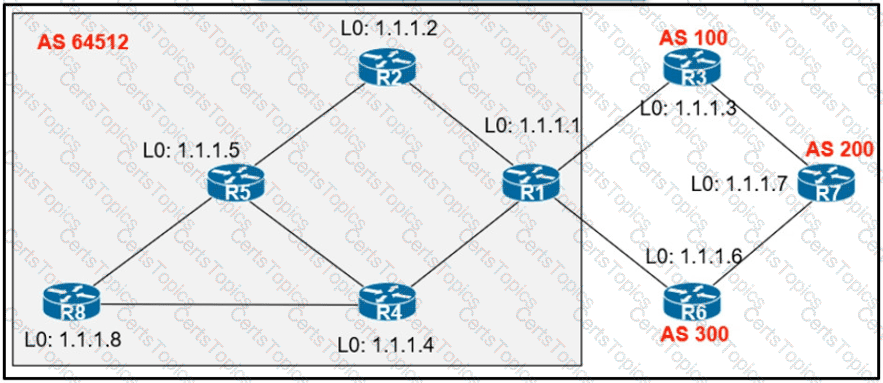
An engineer configured R2 and R5 as route reflectors and noticed that not all routes are sent to R1 to advertise to the eBGP peers. Which iBGP routers must be configured as route reflectors to advertise all routes to restore reachability across all networks?
An engineer configured Reverse Path Forwarding on an interface and noticed that the routes are dropped when a route lookup fails on that interface for a prefix that is available in the routing table Which interface configuration resolves the issue?
Refer to the exhibit.

The network administrator can see the DHCP discovery packet in R1. but R2 is not replying to the DHCP request. The R1 related interface is configured with the DHCP helper address. If the PC is directly connected to the FaO/1 interface on R2, the DHCP server assigns as IP address from the DHCP pool to the PC. Which two commands resolve this issue? (Choose two.)
Refer to the exhibit.
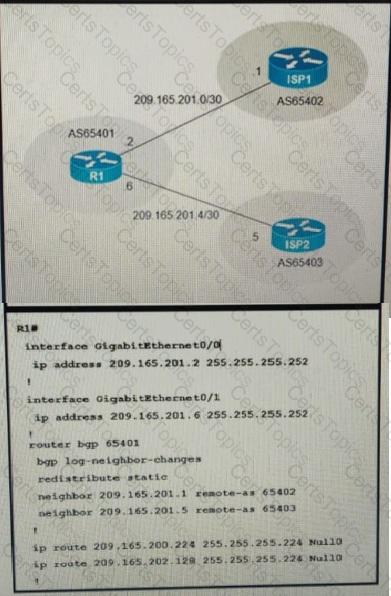
A company with autonomous system number AS65401 has obtained IP address block 209.165.200.224/27 fro, ARIN. The company needed more IP addresses and was assigned block209.165.202.128/27 from ISP2. An engineer is ISP1 reports they are receiving ISP2 routes from AS65401. Which configuration onR1 resolves the issue?
A)

B)

C)

D)

When determining if a system is capable of support, what is the minimum time spacing required for a BFD control packet to receive once a control packet is arrived?
Refer to the exhibit.
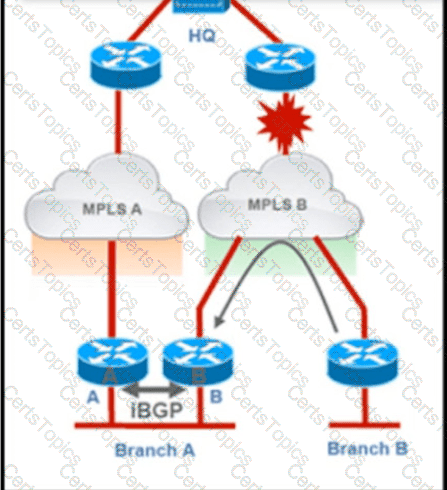
Troubleshoot and ensure that branch B only ever uses the MPLS B network to reach HQ. Which action achieves this requirement?
Refer to the exhibit.
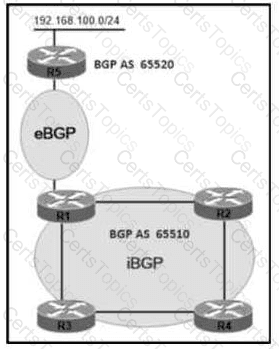
AS65510 iBGP is configured for directly connected neighbors. R4 cannot ping or traceroute network 192 168.100.0/24 Which action resolves this issue?
Refer to exhibit.

Routing protocols are mutually redistributed on R3 and R1. Users report intermittent connectivity to services hosted on the 10.1.1.0/24 prefix. Significant routing update changes are noticed on R3 when the show ip route profile
command is run. How must the services be stabilized?

Refer to the exhibits. An engineer filtered messages based on severity to minimize log messages. After applying the filter, the engineer noticed that it filtered required messages as well. Which action must the engineer take to resolve the issue?
Refer to Exhibit.

A network administrator enables DHCP snooping on the Cisco Catalyst 3750-X switch and configures the uplink port (Port-channel2) as a trusted port. Clients are not receiving an IP address, but when DHCP snooping is disabled, clients start receiving IP addresses. Which global command resolves the issue?
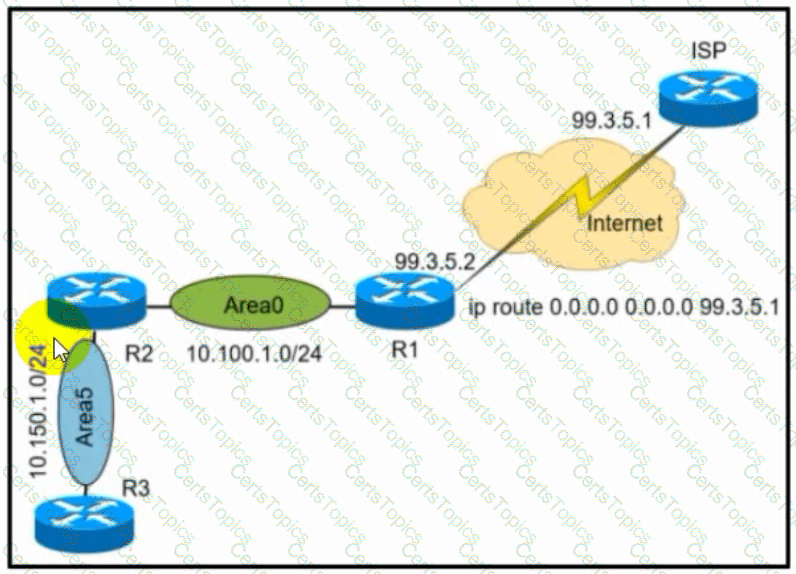
Refer to the exhibit. A network administrator redistributed the default static route into OSPF toward all internal routers to reach to Internet. Which set of commands restores reachability to the Internet by internal routers?
Refer to Exhibit.
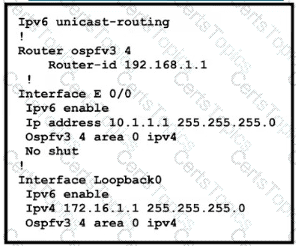
The network administrator configured the branch router for IPv6 on the E0/0 interface. The neighboring router is fully configured to meet requirements, but the neighbor relationship is not coming up. Which action fixes the problem on the branch router to bring the IPv6 neighbors up?
Refer to the exhibit.
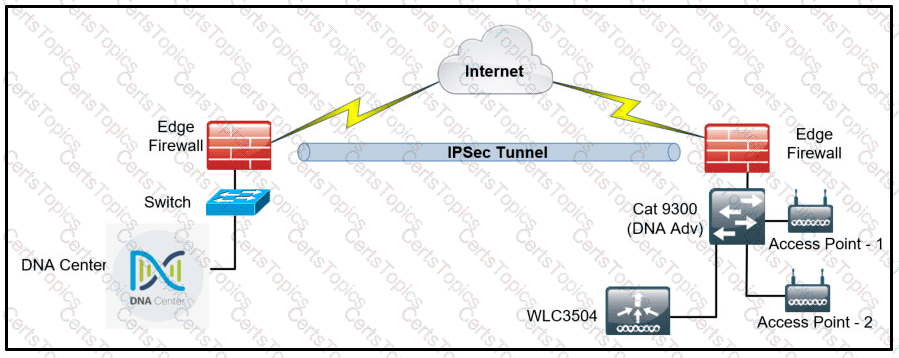
A network administrator is discovering a Cisco Catalyst 9300 and a Cisco WLC 3504 in Cisco DNA Center. The Catalyst 9300 is added successfully However the WLC is showing [ error "uncontactable" when the administrator tries to add it in Cisco DNA Center. Which action discovers WLC in Cisco DNA Center successfully?
An engineer needs dynamic routing between two routers and is unable to establish OSPF adjacency. The output of the show ip ospf neighbor command shows that the neighbor state is EXSTART/EXCHANGE. Which action should be taken to resolve this issue?
What are two purposes of using IPv4 and VPNv4 address-family configurations in a Layer 3 MPLS VPN? (Choose two.)
Refer to the exhibit.
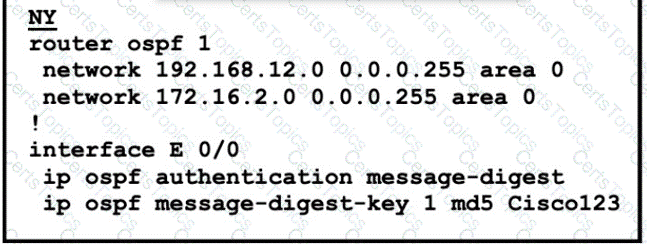
The neighbor relationship is not coming up Which two configurations bring the adjacency up? (Choose two)
How does an MPLS Layer 3 VPN function?
Refer to the exhibit.

A network administrator has developed a Python script on the local Linux machine and is trying to transfer it to the router. However, the transfer fails. Which action resolves this issue?
Which two protocols work in the control plane of P routers across the MPLS cloud? (choose two)
Refer to the exhibit.
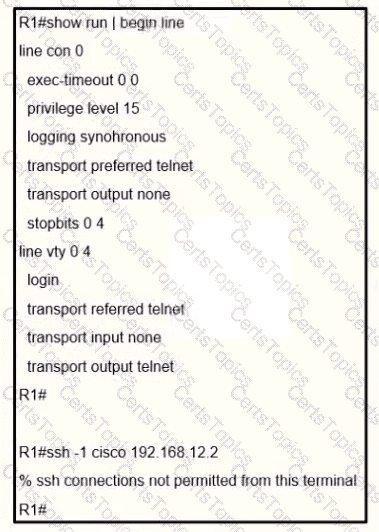
An engineer receives this error message when trying to access another router in-band from the serial interface connected to the console of R1. Which configuration is needed on R1 to resolve this issue?
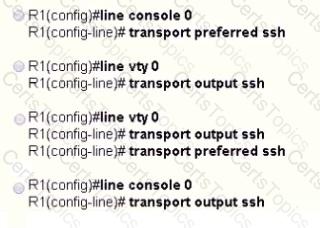
Refer to the exhibit.
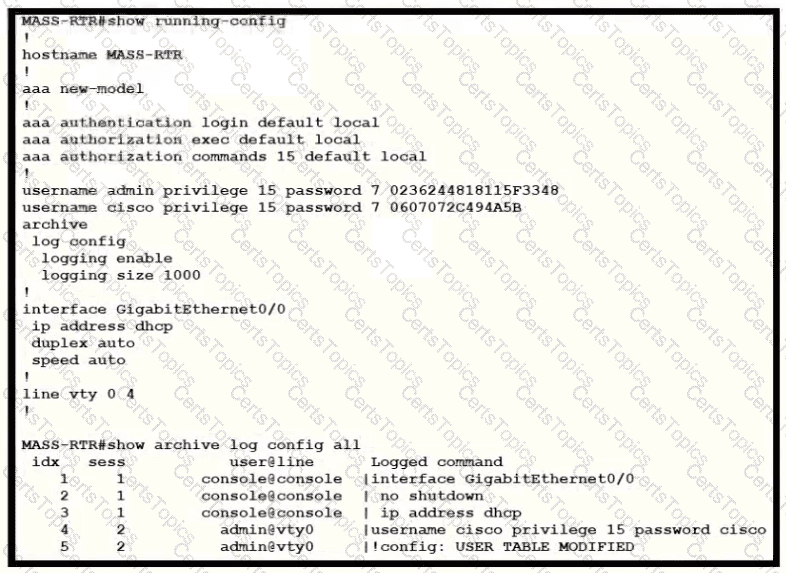
A client is concerned that passwords are visible when running this show archive log config all.
Which router configuration is needed to resolve this issue?
Refer to the exhibit.

Which action resolves the adjacency issue?
Refer to the exhibit.
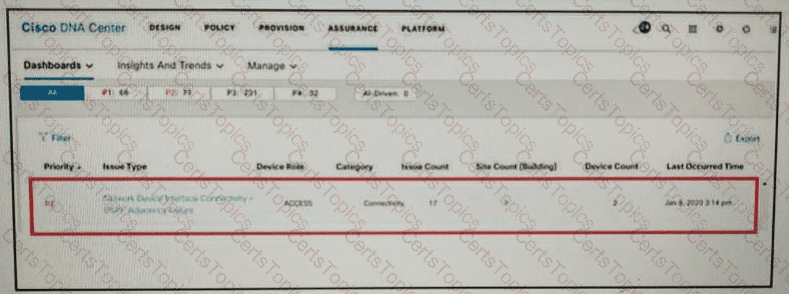
A network administrator is using the DNA Assurance Dashboard panel to troubleshoot an OSPF adjacency that failed between Edge_NYC interface GigabitEthernet1/3 with Neighbor Edge_SNJ. The administrator observes that the neighborship is stuck in exstart state. How does the administrator fix this issue?
Refer to Exhibit.
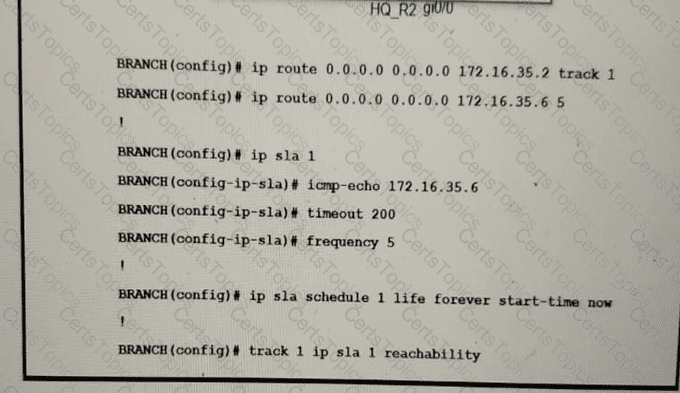
Traffic from the branch network should route through HQ R1 unless the path is unavailable. An engineer tests this functionality by shutting down interface on the BRANCH router toward HQ_R1 router but 192.168.20.0/24 is no longer reachable from the branch router. Which set of configurations resolves the issue?
Refer to the exhibit.
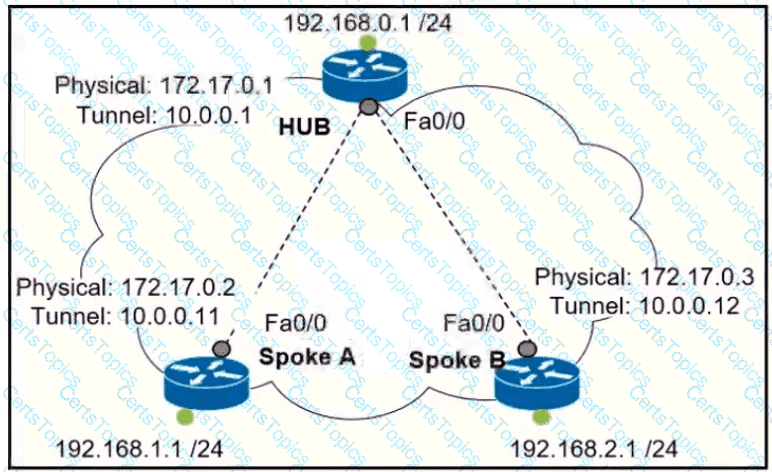
Which interface configuration must be configured on the HUB router to enable MVPN with mGRE mode?
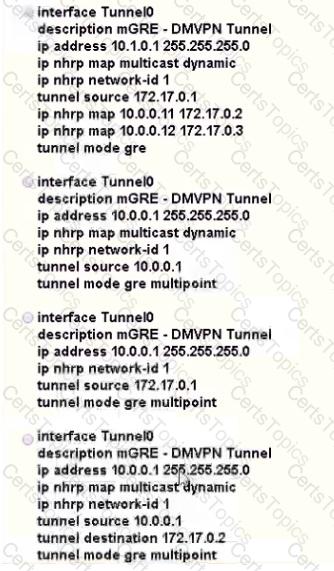
Exhibit:
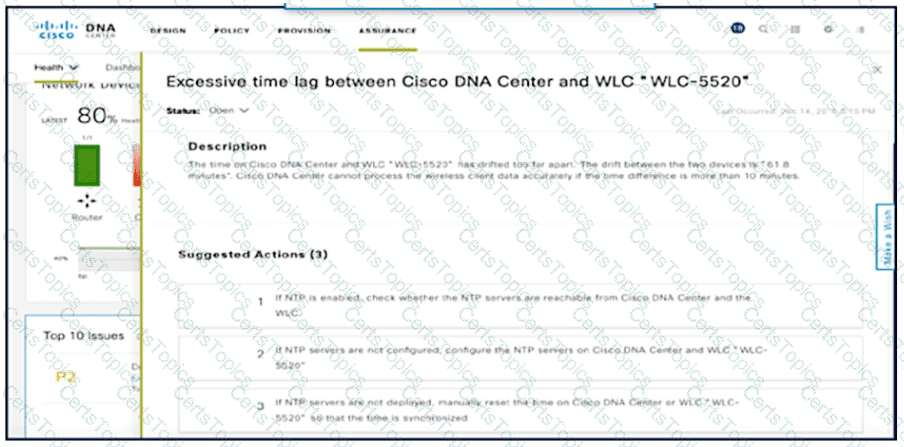
NTP is configured across the network infrastructure and Cisco DNA Center. An NTP issue was reported on the Cisco DNA Center at 17:15. Which action resolves the issue?
Refer to the exhibit.
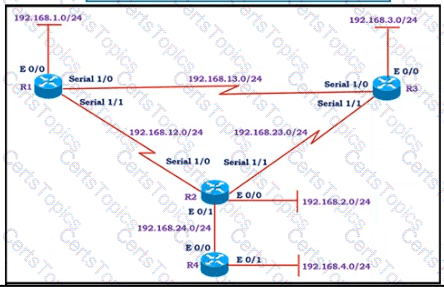
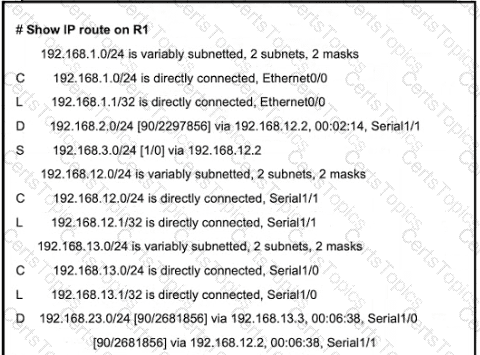
All the serial between R1, R2, and R3 have the Same bandwidth. User on the 192.168.1.0/24 network report slow response times while they access resource on network 192.168.3.0/24. When a traceroute is run on the path. It shows that the packet is getting forwarded via R2 to R3 although the link between R1 and R3 is still up. What must the network administrator to fix the slowness?
Refer to the exhibit.

R1 is connected with R2 via GigabitEthernet0/0, and R2 cannot ping R1. What action will fix the issue?
A network administrator is tasked to permit http and https traffic only toward the internet from the User1 laptop to adhere to company’s security policy. The administrator can still ping to Which interface should the access list 101 be applied to resolve this issue?
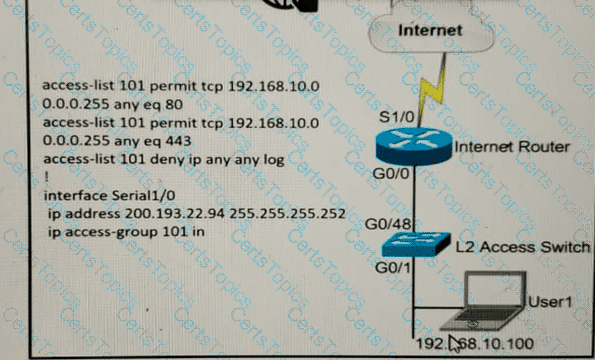
Which Ipv6 first-hop security feature helps to minimize denial of service attacks?
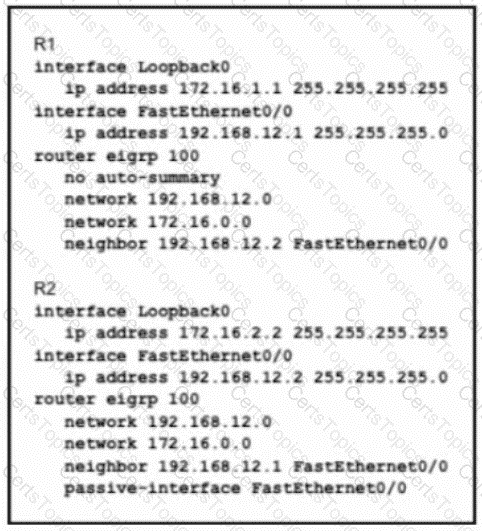
Refer to the exhibit. R1 and R2 cannot establish an EIGRP adjacency. Which action establishes EIGRP adjacency?
Refer to the exhibit.
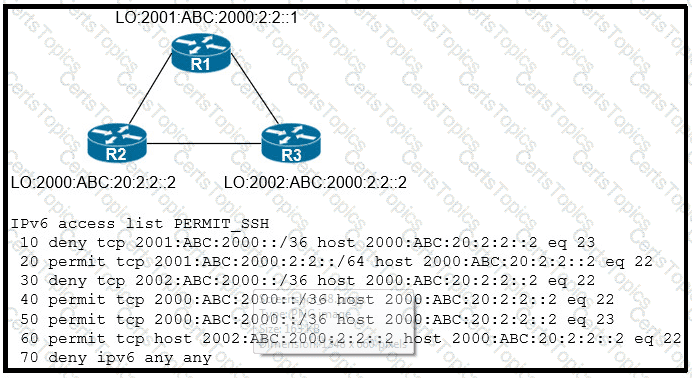
An IPv6 network was newly deployed in the environment and the help desk reports that R3 cannot SSH to the R2s Loopback interface. Which action resolves the issue?